Toshiba RAS-B16GKVP-E, RAS-16GAVP-E, RAS-10GAVP-E, RAS-B13GKVP-E, RAS-13GAVP-E User Manual
...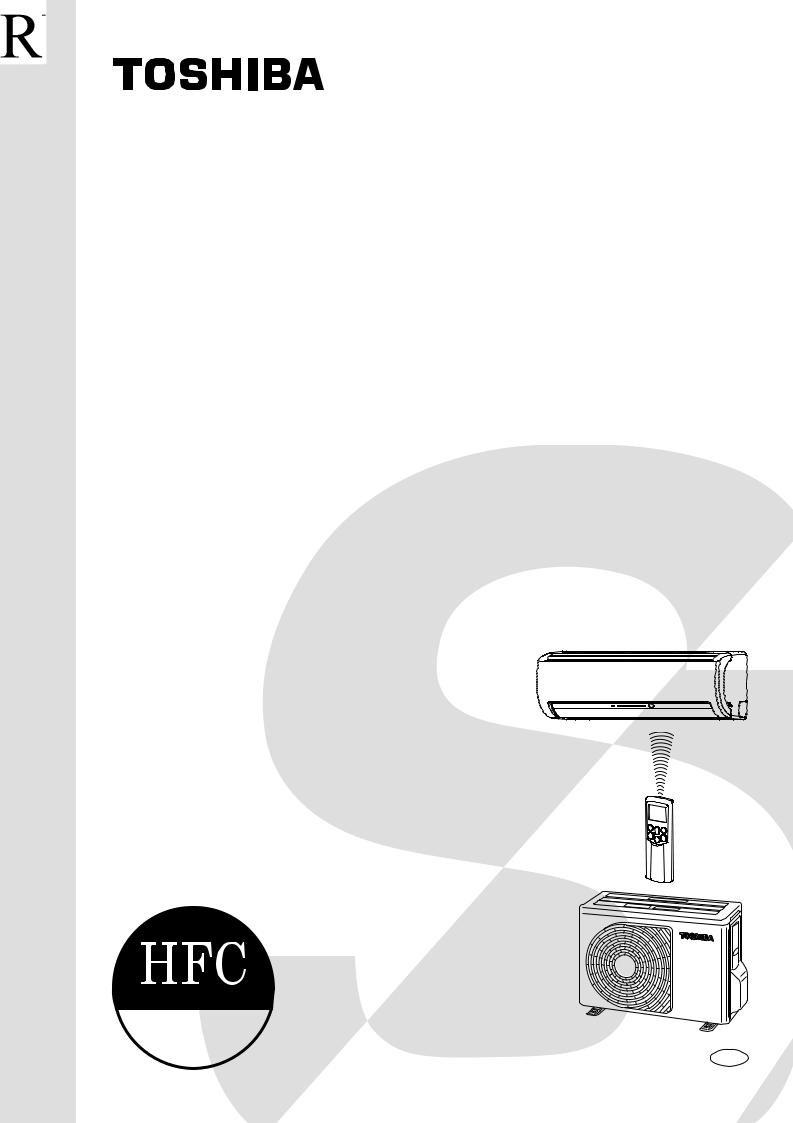
FILE NO. A05-008
SERVICE MANUAL
Indoor Unit
<High Wall, Heat Pump Type>
RAS-B10GKVP-E RAS-B13GKVP-E RAS-B16GKVP-E
SPLIT TYPE
Outdoor Unit
<Heat Pump Type>
RAS-10GAVP-E RAS-13GAVP-E RAS-16GAVP-E
R410A
PRINTED IN JAPAN, Nov.,2005 ToMo
CONTENTS
1. |
SAFETY PRECAUTIONS .......................................................................... |
3 |
2. |
SPECIFICATIONS ..................................................................................... |
5 |
3. |
REFRIGERANT R410A ............................................................................. |
7 |
4. |
CONSTRUCTION VIEWS ........................................................................ |
15 |
5. |
WIRING DIAGRAM .................................................................................. |
17 |
6. |
SPECIFICATIONS OF ELECTRICAL PARTS ......................................... |
18 |
7. |
REFRIGERANT CYCLE DIAGRAM ........................................................ |
19 |
8. |
CONTROL BLOCK DIAGRAM ................................................................ |
22 |
9. |
OPERATION DESCRIPTION ................................................................... |
24 |
10. |
INSTALLATION PROCEDURE ................................................................ |
47 |
11. |
HOW TO DIAGNOSE THE TROUBLE ...................................................... |
60 |
12. |
HOW TO REPLACE THE MAIN PARTS ................................................... |
82 |
13. EXPLODED VIEWS AND PARTS LIST ................................................. |
101 |
|
Cord Heater Installation Work ........................................................ |
Appendix-1 |
|
– 2 –
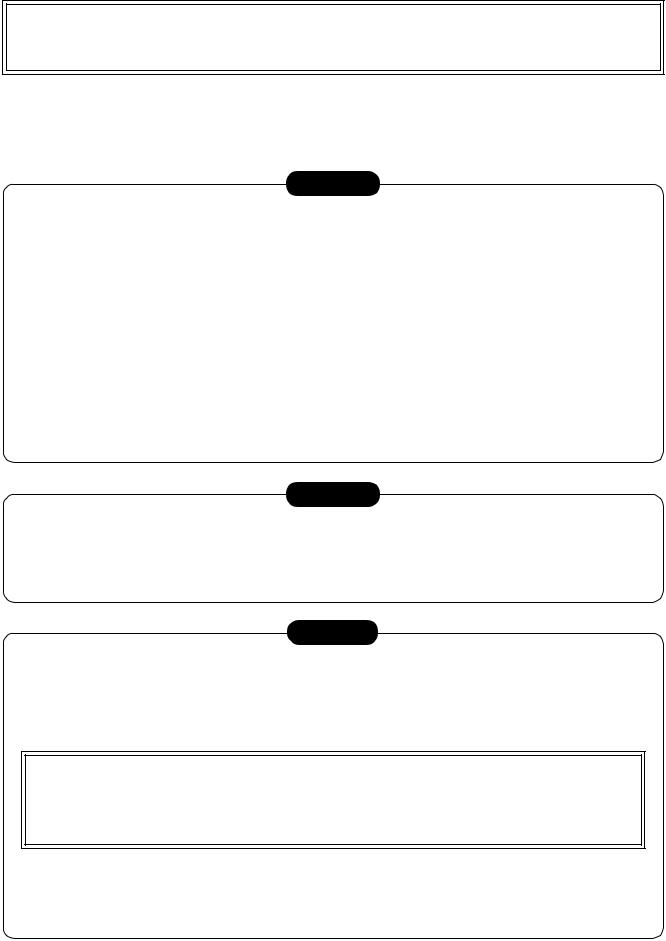
1. SAFETY PRECAUTIONS
For general public use
Power supply cord of outdoor unit shall be more than 1.5 mm 2 (H07RN-F or 245IEC66) polychloroprene sheathed flexible cord.
•Read this “SAFETY PRECAUTIONS” carefully before servicing.
•The precautions described below include the important items regarding safety. Observe them without fail.
•After the servicing work, perform a trial operation to check for any problem.
•Turn off the main power supply switch (or breaker) before the unit maintenance.
CAUTION
New Refrigerant Air Conditioner Installation
•THIS AIR CONDITIONER ADOPTS THE NEW HFC REFRIGERANT (R410A) WHICH DOES NOT DESTROY OZONE LAYER.
R410A refrigerant is apt to be affected by impurities such as water, oxidizing membrane, and oils because the working pressure of R410A refrigerant is approx. 1.6 times of refrigerant R22. Accompanied with the adoption of the new refrigerant, the refrigeration machine oil has also been changed. Therefore, during installation work, be sure that water, dust, former refrigerant, or refrigeration machine oil does not enter into the new type refrigerant R410A air conditioner circuit.
To prevent mixing of refrigerant or refrigerating machine oil, the sizes of connecting sections of charging port on main unit and installation tools are different from those used for the conventional refrigerant units.
Accordingly, special tools are required for the new refrigerant (R410A) units. For connecting pipes, use new and clean piping materials with high pressure fittings made for R410A only, so that water and/or dust does not enter. Moreover, do not use the existing piping because there are some problems with pressure fittings and possible impurities in existing piping.
CAUTION
TO DISCONNECT THE APPLIANCE FROM THE MAIN POWER SUPPLY
This appliance must be connected to the main power supply by a circuit breaker or a switch with a contact separation of at least 3 mm.
The installation fuse (25A D type  ) must be used for the power supply line of this air conditioner.
) must be used for the power supply line of this air conditioner.
DANGER
•ASK AN AUTHORIZED DEALER OR QUALIFIED INSTALLATION PROFESSIONAL TO INSTALL/MAINTAIN THE AIR CONDITIONER.
INAPPROPRIATE SERVICING MAY RESULT IN WATER LEAKAGE, ELECTRIC SHOCK OR FIRE.
•TURN OFF MAIN POWER SUPPLY BEFORE ATTEMPTING ANY ELECTRICAL WORK. MAKE SURE ALL POWER SWITCHES ARE OFF. FAILURE TO DO SO MAY CAUSE ELECTRIC SHOCK.
 DANGER: HIGH VOLTAGE
DANGER: HIGH VOLTAGE
The high voltage circuit is incorporated.
Be careful to do the check service, as the electric shock may be caused in case of touching parts on the P.C. board by hand.
•CORRECTLY CONNECT THE CONNECTING CABLE. IF THE CONNECTING CABLE IS INCORRECTLY CONNECTED, ELECTRIC PARTS MAY BE DAMAGED.
•CHECK THAT THE EARTH WIRE IS NOT BROKEN OR DISCONNECTED BEFORE SERVICE AND INSTALLATION. FAILURE TO DO SO MAY CAUSE ELECTRIC SHOCK.
–3 –

•DO NOT INSTALL NEAR CONCENTRATIONS OF COMBUSTIBLE GAS OR GAS VAPORS. FAILURE TO FOLLOW THIS INSTRUCTION CAN RESULT IN FIRE OR EXPLOSION.
•TO PREVENT THE INDOOR UNIT FROM OVERHEATING AND CAUSING A FIRE HAZARD, PLACE THE UNIT WELL AWAY (MORE THAN 2 M) FROM HEAT SOURCES SUCH AS RADIATORS, HEAT REGISTORS, FURNACE, STOVES, ETC.
•WHEN MOVING THE AIR-CONDITIONER FOR INSTALLATION IN ANOTHER PLACE, BE VERY CAREFUL NOT TO ALLOW THE SPECIFIED REFRIGERANT (R410A) TO BECOME MIXED WITH ANY OTHER GASEOUS BODY INTO THE REFRIGERATION CIRCUIT. IF AIR OR ANY OTHER GAS IS MIXED IN THE REFRIGERANT, THE GAS PRESSURE IN THE REFRIGERATION CIRCUIT WILL BECOME ABNORMALLY HIGH AND IT MAY RESULT IN THE PIPE BURSTING AND POSSIBLE PERSONNEL INJURIES.
•IN THE EVENT THAT THE REFRIGERANT GAS LEAKS OUT OF THE PIPE DURING THE SERVICE WORK AND THE INSTALLATION WORK, IMMEDIATELY LET FRESH AIR INTO THE ROOM. IF THE REFRIGERANT GAS IS HEATED, SUCH AS BY FIRE, GENERATION OF POISONOUS GAS MAY RESULT.
WARNING
•Never modify this unit by removing any of the safety guards or bypass any of the safety interlock switches.
•Do not install in a place which cannot bear the weight of the unit. Personal injury and property damage can result if the unit falls.
•After the installation work, confirm that refrigerant gas does not leak.
If refrigerant gas leaks into the room and flows near a fire source, such as a cooking range, noxious gas may generate.
•The electrical work must be performed by a qualified electrician in accordance with the Installation Manual. Make sure the air conditioner uses an exclusive circuit.
An insufficient circuit capacity or inappropriate installation may cause fire.
•When wiring, use the specified cables and connect the terminals securely to prevent external forces applied to the cable from affecting the terminals.
•Be sure to provide grounding.
Do not connect ground wires to gas pipes, water pipes, lightning rods or ground wires for telephone cables.
•Conform to the regulations of the local electric company when wiring the power supply.
Inappropriate grounding may cause electric shock.
CAUTION
•Exposure of unit to water or other moisture before installation may result in an electrical short. Do not store in a wet basement or expose to rain or water.
•Do not install in a place that can increase the vibration of the unit. Do not install in a place that can amplify the noise level of the unit or where noise or discharged air might disturb neighbors.
•To avoid personal injury, be careful when handling parts with sharp edges.
•Perform the specified installation work to guard against an earthquake.
If the air conditioner is not installed appropriately, accidents may occur due to the falling unit.
For Reference:
If a heating operation would be continuously performed for a long time under the condition that the outdoor temperature is 0°C or lower, drainage of defrosted water may be difficult due to freezing of the bottom plate, resulting in a trouble of the cabinet or fan.
It is recommended to procure an antifreeze heater locally for a safe installation of the air conditioner.
For details, contact the dealer.
– 4 –
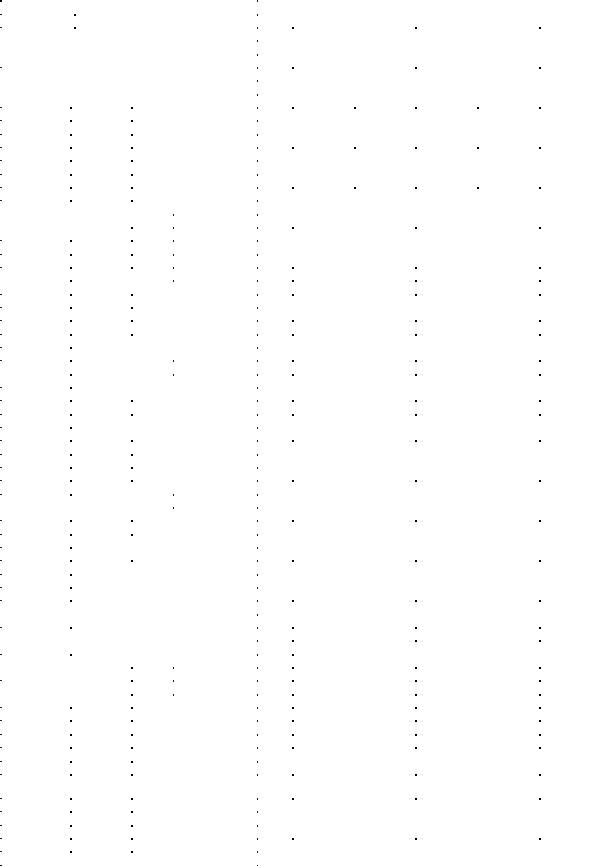
2. SPECIFICATIONS
2-1. Specifications
RAS-B10GKVP-E/RAS-B13GKVP-E/RAS-B16GKVP-E, RAS-10GAVP-E/RAS-13GAVP-E/RAS-16GAVP-E
Unit model |
|
Indoor |
|
|
|
RAS-B10GKVP-E |
RAS-B13GKVP-E |
RAS-B16GKVP-E |
|||||||
|
Outdoor |
|
|
|
RAS-10GAVP-E |
RAS-13GAVP-E |
RAS-16GAVP-E |
||||||||
|
|
|
|
|
|||||||||||
Cooling capacity |
|
|
(kW) |
2.5 |
3.5 |
4.5 |
|||||||||
Cooling capacity range |
|
|
(kW) |
0.5–3.5 |
0.6–4.5 |
0.8–5.0 |
|||||||||
Heating capacity |
|
|
(kW) |
3.2 |
4.2 |
5.5 |
|||||||||
Heating capacity range |
|
|
(kW) |
0.6–5.8 |
0.6–6.6 |
0.8–7.8 |
|||||||||
Power supply |
|
|
|
|
|
|
|
|
1 Ph/50Hz/220–240 V, 1 Ph/60Hz/220 V |
|
|||||
|
|
|
|
Operation mode |
|
Cooling |
|
Heating |
Cooling |
|
Heating |
Cooling |
|
Heating |
|
|
Indoor |
|
Running current |
(A) |
0.15 |
|
0.15 |
0.15 |
|
0.15 |
0.15 |
|
0.15 |
||
|
|
Power consumption |
(W) |
30 |
|
30 |
30 |
|
30 |
30 |
|
30 |
|||
|
|
|
|
|
|
|
|||||||||
Electric |
|
|
|
Power factor |
(%) |
87 |
|
87 |
87 |
|
87 |
87 |
|
87 |
|
|
|
|
Operation mode |
|
Cooling |
|
Heating |
Cooling |
|
Heating |
Cooling |
|
Heating |
||
characteristics |
|
|
|
|
|
|
|
||||||||
|
|
|
Running current |
(A) |
2.48/2.37/2.26 |
|
3.25/3.10/2.96 |
4.25/4.06/3.89 |
|
4.52/4.31/4.13 |
6.45/6.17/5.90 |
|
7.07/6.76/6.47 |
||
|
|
|
|
|
|
|
|||||||||
|
Outdoor |
|
Power consumption |
(W) |
520 |
|
680 |
890 |
|
945 |
1350 |
|
1480 |
||
|
|
|
|
Power factor |
(%) |
95 |
|
95 |
95 |
|
95 |
95 |
|
95 |
|
|
|
|
|
Starting current |
(A) |
3.40/3.25/3.11 |
4.67/4.46/4.28 |
7.22/6.91/6.62 |
|||||||
COP |
|
|
|
|
(Cooling/Heating) |
|
4.55/4.51 |
3.80/4.31 |
3.26/3.64 |
||||||
|
|
|
|
High |
(Cooling/Heating) |
(dB•A) |
42/43 |
43/44 |
45/45 |
||||||
Operating |
Indoor |
|
Medium |
(Cooling/Heating) |
(dB•A) |
33/34 |
34/35 |
36/36 |
|||||||
noise |
|
|
|
Low |
(Cooling/Heating) |
(dB•A) |
27/27 |
27/27 |
29/29 |
||||||
|
Outdoor |
|
(Cooling/Heating) |
(dB•A) |
46/47 |
48/50 |
49/50 |
||||||||
|
Unit model |
|
|
|
RAS-B10GKVP-E |
RAS-B13GKVP-E |
RAS-B16GKVP-E |
||||||||
|
|
|
|
Height |
|
(mm) |
250 |
250 |
250 |
||||||
|
Dimension |
|
Width |
|
(mm) |
790 |
790 |
790 |
|||||||
Indoor unit |
|
|
|
Depth |
|
(mm) |
215 |
215 |
215 |
||||||
|
Net weight |
|
|
(kg) |
|
9 |
9 |
|
9 |
|
|||||
|
Fan motor output |
|
(W) |
30 |
30 |
30 |
|||||||||
|
Air flow rate |
|
(Cooling/Heating) |
(m³/h) |
550/610 |
560/640 |
640/660 |
||||||||
|
Unit model |
|
|
|
RAS-10GAVP-E |
RAS-13GAVP-E |
RAS-16GAVP-E |
||||||||
|
|
|
|
Height |
|
(mm) |
550 |
550 |
550 |
||||||
|
Dimension |
|
Width |
|
(mm) |
780 |
780 |
780 |
|||||||
|
|
|
|
Depth |
|
(mm) |
290 |
290 |
290 |
||||||
Outdoor unit |
Net weight |
|
|
(kg) |
35 |
37 |
37 |
||||||||
|
|
|
Motor output |
(W) |
750 |
750 |
750 |
||||||||
|
|
|
|
||||||||||||
|
Compressor |
|
Type |
|
|
|
|
Twin rotary type with DC-inverter variable speed control |
|
||||||
|
|
|
|
Model |
|
|
DA111A1F-20F1 |
DA111A1F-20F1 |
DA111A1F-20F1 |
||||||
|
Fan motor output |
|
(W) |
43 |
43 |
43 |
|||||||||
|
Air flow rate |
|
(Cooling/Heating) |
(m³/h) |
2150/2150 |
2410/2410 |
2410/2410 |
||||||||
|
Type |
|
|
|
Flare connection |
Flare connection |
Flare connection |
||||||||
|
Indoor unit |
|
Liquid side |
|
Ø6.35 |
Ø6.35 |
Ø6.35 |
||||||||
|
|
Gas side |
|
|
Ø9.52 |
Ø9.52 |
Ø12.7 |
||||||||
|
|
|
|
|
|
||||||||||
Piping |
Outdoor unit |
|
Liquid side |
|
Ø6.35 |
Ø6.35 |
Ø6.35 |
||||||||
connection |
|
Gas side |
|
|
Ø9.52 |
Ø9.52 |
Ø12.7 |
||||||||
|
Maximum length |
|
(m) |
25 |
25 |
25 |
|||||||||
|
Maximum chargeless length |
(m) |
15 |
15 |
15 |
||||||||||
|
Maximum height difference |
(m) |
10 |
10 |
10 |
||||||||||
Refrigerant |
Name of refrigerant |
|
|
R410A |
R410A |
R410A |
|||||||||
Weight |
|
|
(kg) |
0.82 |
0.96 |
0.96 |
|||||||||
|
|
|
|||||||||||||
Wiring |
Power supply |
|
|
|
|
|
3 Wires : includes earth (Outdoor) |
|
|||||||
connection |
Interconnection |
|
|
|
|
|
4 Wires : includes earth |
|
|
|
|||||
Usable temperature range |
|
Indoor |
(Cooling/Heating) |
(°C) |
21–32/0–28 |
21–32/0–28 |
21–32/0–28 |
||||||||
|
Outdoor |
(Cooling/Heating) |
(°C) |
5–43/–15–24 |
5–43/–15–24 |
5–43/–15–24 |
|||||||||
|
|
|
|
||||||||||||
|
|
|
|
Installation plate |
|
|
1 |
1 |
|
1 |
|
||||
|
|
|
|
Wireless remote controller |
|
|
1 |
1 |
|
1 |
|
||||
|
|
|
|
Batteries |
|
|
|
2 |
2 |
|
2 |
|
|||
|
|
|
|
Remote controller holder |
|
|
1 |
1 |
|
1 |
|
||||
|
|
|
|
Zeolite-plus filter |
|
|
1 |
1 |
|
1 |
|
||||
|
Indoor unit |
|
Mounting screw |
|
6 (Ø4 × 25L) |
6 (Ø4 × 25L) |
6 (Ø4 × 25L) |
||||||||
Accessory |
|
|
|
Remote controller holder |
|
2 (Ø3.1 × 16L) |
2 (Ø3.1 × 16L) |
2 (Ø3.1 × 16L) |
|||||||
|
|
|
|
mounting screw |
|
||||||||||
|
|
|
|
|
|
|
|
|
|
|
|
|
|
||
|
|
|
|
Plasma pure filter |
|
|
1 |
1 |
|
1 |
|
||||
|
|
|
|
Installation manual |
|
|
1 |
1 |
|
1 |
|
||||
|
|
|
|
Owner’s manual |
|
|
1 |
1 |
|
1 |
|
||||
|
Outdoor unit |
|
Drain nipple |
|
|
1 |
1 |
|
1 |
|
|||||
|
|
Water-proof rubber cap |
|
|
2 |
2 |
|
2 |
|
||||||
•The specifications may be subject to change without notice for purpose of improvement.
–5 –
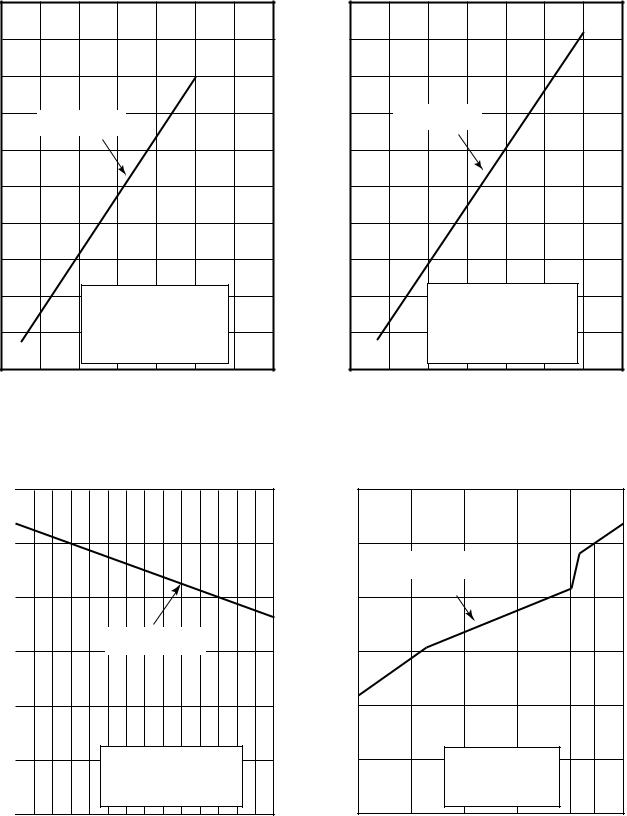
2-2. Operation Characteristic Curve |
|
|
|
|
|
|
|
|
|
|
|||||||
<Cooling> |
|
|
|
|
|
|
<Heating> |
|
|
|
|
|
|
||||
|
10 |
|
|
|
|
|
|
|
10 |
|
|
|
|
|
|
|
|
|
9 |
|
|
|
|
|
|
|
|
9 |
|
|
|
|
|
|
|
|
8 |
|
|
|
|
|
|
|
|
8 |
|
|
|
|
|
|
|
|
7 |
RAS-B10GKVP-E |
|
|
|
|
|
7 |
RAS-B10GKVP-E |
|
|
|
|
||||
|
|
|
|
|
|
RAS-B13GKVP-E |
|
|
|
|
|||||||
|
RAS-B13GKVP-E |
|
|
|
|
|
|
|
|
|
|||||||
|
|
|
|
|
|
|
|
RAS-B16GKVP-E |
|
|
|
|
|||||
|
|
RAS-B16GKVP-E |
|
|
|
|
|
|
|
|
|
|
|||||
|
|
|
|
|
|
|
|
|
|
|
|
|
|
|
|||
|
6 |
|
|
|
|
|
|
|
|
6 |
|
|
|
|
|
|
|
(A) |
5 |
|
|
|
|
|
|
|
(A) |
5 |
|
|
|
|
|
|
|
|
|
|
|
|
|
|
|
|
|
|
|
|
|
|
|
||
Current |
4 |
|
|
|
|
|
|
|
Current |
4 |
|
|
|
|
|
|
|
|
|
|
|
|
|
|
|
|
|
|
|
|
|
|
|
||
|
3 |
|
|
|
|
|
|
|
|
3 |
|
|
|
|
|
|
|
|
2 |
|
|
• Conditions |
|
|
|
|
|
2 |
|
• Conditions |
|
|
|
|
|
|
|
|
|
Indoor : DB 27˚C/WB 19˚C |
|
|
|
|
|
Indoor : DB 20˚C |
|
|
|
||||
|
|
|
|
Outdoor : DB 35˚C |
|
|
|
|
|
|
Outdoor : DB 7˚C/WB 6˚C |
|
|
||||
|
1 |
|
|
Air flow : High |
|
|
|
|
1 |
|
Air flow : High |
|
|
|
|||
|
|
|
|
Pipe length : 7.5m |
|
|
|
|
|
|
Pipe length : 7.5m |
|
|
|
|||
|
|
|
|
Voltage : 230V |
|
|
|
|
|
|
Voltage : 230V |
|
|
|
|||
|
00 |
20 |
40 |
60 |
80 |
100 |
120 |
140 |
|
00 |
20 |
40 |
60 |
80 |
100 |
120 |
140 |
Compressor speed (rps) |
Compressor speed (rps) |
2-3. Capacity Variation Ratio According to Temperature
<Cooling>
|
110 |
|
|
|
|
|
100 |
|
ratio (%) |
90 |
|
80 |
|
|
Capacity |
|
|
70 |
|
|
|
|
|
|
60 |
|
|
50 |
|
|
|
|
|
32 33 34 35 36 |
|
RAS-B10GKVP-E
RAS-B13GKVP-E
RAS-B16GKVP-E
• Conditions
Indoor : DB27˚C/WB19˚C Indoor air flow : High Pipe length : 7.5m
37 38 39 40 41 42 43 44 45 46
<Heating> |
|
|
|
|
|
|
|
120 |
|
|
|
|
|
|
100 |
|
|
|
|
|
|
|
RAS-B10GKVP-E |
|
|
|
|
|
|
RAS-B13GKVP-E |
|
|
|
|
|
80 |
RAS-B16GKVP-E |
|
|
|
|
ratio (%) |
|
|
|
|
|
|
60 |
|
|
|
|
|
|
Capacity |
|
|
|
|
|
|
40 |
|
|
|
|
|
|
|
|
|
|
|
|
|
|
20 |
|
• Conditions |
|
|
|
|
|
|
Indoor : DB 20˚C |
|
|
|
|
|
|
Indoor air flow : High |
|
|
|
|
|
|
Pipe length : 7.5m |
|
|
|
|
0 |
–10 |
–5 |
0 |
5 |
10 |
|
–15 |
|||||
Outdoor temp. (˚C) |
Outdoor temp. (˚C) |
*Capacity ratio :100% = 2.5 kW (RAS-B10GKVP-E)
3.5kW (RAS-B13GKVP-E)
4.5kW (RAS-B16GKVP-E)
– 6 –
3. REFRIGERANT R410A
This air conditioner adopts the new refrigerant HFC (R410A) which does not damage the ozone layer.
The working pressure of the new refrigerant R410A is 1.6 times higher than conventional refrigerant (R22). The refrigerating oil is also changed in accordance with change of refrigerant, so be careful that water, dust, and existing refrigerant or refrigerating oil are not entered in the refrigerant cycle of the air conditioner using the new refrigerant during installation work or servicing time.
The next section describes the precautions for air conditioner using the new refrigerant. Conforming to contents of the next section together with the general cautions included in this manual, perform the correct and safe work.
3-1. Safety During Installation/Servicing
As R410A’s pressure is about 1.6 times higher than that of R22, improper installation/servicing may cause a serious trouble. By using tools and materials exclusive for R410A, it is necessary to carry out installation/servicing safely while taking the following precautions into consideration.
1.Never use refrigerant other than R410A in an air conditioner which is designed to operate with R410A.
If other refrigerant than R410A is mixed, pressure in the refrigeration cycle becomes abnormally high, and it may cause personal injury, etc. by a rupture.
2.Confirm the used refrigerant name, and use tools and materials exclusive for the refrigerant R410A.
The refrigerant name R410A is indicated on the visible place of the outdoor unit of the air conditioner using R410A as refrigerant. To prevent mischarging, the diameter of the service port differs from that of R22.
3.If a refrigeration gas leakage occurs during installation/servicing, be sure to ventilate fully.
If the refrigerant gas comes into contact with fire, a poisonous gas may occur.
4.When installing or removing an air conditioner, do not allow air or moisture to remain in the refrigeration cycle. Otherwise, pressure in the refrigeration cycle may become abnormally high so that a rupture or personal injury may be caused.
5.After completion of installation work, check to make sure that there is no refrigeration gas leakage.
If the refrigerant gas leaks into the room, coming into contact with fire in the fan-driven heater, space heater, etc., a poisonous gas may occur.
6.When an air conditioning system charged with a large volume of refrigerant is installed in a small room, it is necessary to exercise care so that, even when refrigerant leaks, its concentration does not exceed the marginal level.
If the refrigerant gas leakage occurs and its concentration exceeds the marginal level, an oxygen starvation accident may result.
7.Be sure to carry out installation or removal according to the installation manual.
Improper installation may cause refrigeration trouble, water leakage, electric shock, fire, etc.
8.Unauthorized modifications to the air conditioner may be dangerous. If a breakdown occurs please call a qualified air conditioner technician or electrician.
Improper repair’s may result in water leakage, electric shock and fire, etc.
3-2. Refrigerant Piping Installation
3-2-1. Piping Materials and Joints Used
For the refrigerant piping installation, copper pipes and joints are mainly used. Copper pipes and joints suitable for the refrigerant must be chosen and installed. Furthermore, it is necessary to use clean copper pipes and joints whose interior surfaces are less affected by contaminants.
1.Copper Pipes
It is necessary to use seamless copper pipes which are made of either copper or copper alloy and it is desirable that the amount of residual oil is less than 40 mg/10 m. Do not use copper pipes having a collapsed, deformed or discolored portion (especially on the interior surface).
Otherwise, the expansion valve or capillary tube may become blocked with contaminants.
As an air conditioner using R410A incurs pressure higher than when using R22, it is necessary to choose adequate materials.
Thicknesses of copper pipes used with R410A are as shown in Table 3-2-1. Never use copper pipes thinner than 0.8 mm even when it is available on the market.
– 7 –
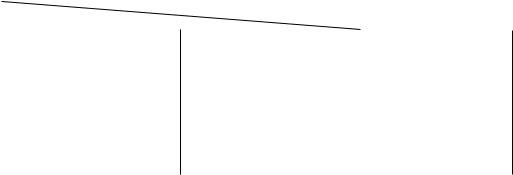
Table 3-2-1 Thicknesses of annealed copper pipes
|
|
|
Thickness (mm) |
|
|
|
|
Nominal diameter |
Outer diameter (mm) |
R410A |
R22 |
|
|
|
|
1/4 |
6.35 |
0.80 |
0.80 |
|
|
|
|
3/8 |
9.52 |
0.80 |
0.80 |
|
|
|
|
1/2 |
12.70 |
0.80 |
0.80 |
|
|
|
|
5/8 |
15.88 |
1.00 |
1.00 |
|
|
|
|
2.Joints
For copper pipes, flare joints or socket joints are used. Prior to use, be sure to remove all contaminants.
a)Flare Joints
Flare joints used to connect the copper pipes cannot be used for pipings whose outer diameter exceeds 20 mm. In such a case, socket joints can be used.
Sizes of flare pipe ends, flare joint ends and flare nuts are as shown in Tables 3-2-3 to 3-2-6 below.
b)Socket Joints
Socket joints are such that they are brazed for connections, and used mainly for thick pipings whose diameter is larger than 20 mm.
Thicknesses of socket joints are as shown in Table 3-2-2.
Table 3-2-2 Minimum thicknesses of socket joints
Nominal diameter |
Reference outer diameter of |
Minimum joint thickness |
|
copper pipe jointed (mm) |
(mm) |
||
|
|||
|
|
|
|
1/4 |
6.35 |
0.50 |
|
|
|
|
|
3/8 |
9.52 |
0.60 |
|
|
|
|
|
1/2 |
12.70 |
0.70 |
|
|
|
|
|
5/8 |
15.88 |
0.80 |
|
|
|
|
3-2-2. Processing of Piping Materials
When performing the refrigerant piping installation, care should be taken to ensure that water or dust does not enter the pipe interior, that no other oil than lubricating oils used in the installed air-water heat pump is used, and that refrigerant does not leak. When using lubricating oils in the piping processing, use such lubricating oils whose water content has been removed. When stored, be sure to seal the container with an airtight cap or any other cover.
1.Flare processing procedures and precautions
a)Cutting the Pipe
By means of a pipe cutter, slowly cut the pipe so that it is not deformed.
b)Removing Burrs and Chips
If the flared section has chips or burrs, refrigerant leakage may occur. Carefully remove all burrs and clean the cut surface before installation.
c)Insertion of Flare Nut
– 8 –

d) Flare Processing
Make certain that a clamp bar and copper pipe have been cleaned.
By means of the clamp bar, perform the flare processing correctly.
Use either a flare tool for R410A or conventional flare tool.
Flare processing dimensions differ according to the type of flare tool. When using a conventional flare tool, be sure to secure “dimension A” by using a gauge for size adjustment.
ØD |
A |
Fig. 3-2-1 Flare processing dimensions
Table 3-2-3 Dimensions related to flare processing for R410A
|
Outer |
|
|
|
A (mm) |
|
|
|
|
|
|
|
|
||
Nominal |
Thickness |
|
|
|
|||
diameter |
Flare tool for R410A |
Conventional flare tool |
|||||
diameter |
(mm) |
||||||
(mm) |
|
|
|||||
|
|
|
clutch type |
Clutch type |
Wing nut type |
||
|
|
|
|
||||
|
|
|
|
|
|||
|
|
|
|
|
|
|
|
1/4 |
6.35 |
0.8 |
|
0 to 0.5 |
1.0 to 1.5 |
1.5 to 2.0 |
|
|
|
|
|
|
|
|
|
3/8 |
9.52 |
0.8 |
|
0 to 0.5 |
1.0 to 1.5 |
1.5 to 2.0 |
|
|
|
|
|
|
|
|
|
1/2 |
12.70 |
0.8 |
|
0 to 0.5 |
1.0 to 1.5 |
2.0 to 2.5 |
|
|
|
|
|
|
|
|
|
5/8 |
15.88 |
1.0 |
|
0 to 0.5 |
1.0 to 1.5 |
2.0 to 2.5 |
|
|
|
|
|
|
|
|
|
|
Table 3-2-4 Dimensions related to flare processing for R22 |
|
|||||
|
|
|
|
|
|
|
|
|
Outer |
|
|
|
A (mm) |
|
|
|
|
|
|
|
|
||
Nominal |
Thickness |
|
|
|
|||
diameter |
Flare tool for R22 |
Conventional flare tool |
|||||
diameter |
(mm) |
||||||
(mm) |
|
|
|||||
|
|
|
clutch type |
Clutch type |
Wing nut type |
||
|
|
|
|
||||
|
|
|
|
|
|||
|
|
|
|
|
|
|
|
1/4 |
6.35 |
0.8 |
|
0 to 0.5 |
0.5 to 1.0 |
1.0 to 1.5 |
|
|
|
|
|
|
|
|
|
3/8 |
9.52 |
0.8 |
|
0 to 0.5 |
0.5 to 1.0 |
1.0 to 1.5 |
|
|
|
|
|
|
|
|
|
1/2 |
12.70 |
0.8 |
|
0 to 0.5 |
0.5 to 1.0 |
1.5 to 2.0 |
|
|
|
|
|
|
|
|
|
5/8 |
15.88 |
1.0 |
|
0 to 0.5 |
0.5 to 1.0 |
1.5 to 2.0 |
|
|
|
|
|
|
|
|
|
Table 3-2-5 Flare and flare nut dimensions for R410A
Nominal |
Outer diameter |
Thickness |
|
Dimension (mm) |
|
Flare nut width |
|||
|
|
|
|
|
|
||||
diameter |
(mm) |
(mm) |
A |
|
B |
C |
|
D |
(mm) |
|
|
|
|
|
|
||||
|
|
|
|
|
|
|
|
|
|
1/4 |
6.35 |
0.8 |
9.1 |
|
9.2 |
6.5 |
|
13 |
17 |
|
|
|
|
|
|
|
|
|
|
3/8 |
9.52 |
0.8 |
13.2 |
|
13.5 |
9.7 |
|
20 |
22 |
|
|
|
|
|
|
|
|
|
|
1/2 |
12.70 |
0.8 |
16.6 |
|
16.0 |
12.9 |
|
23 |
26 |
|
|
|
|
|
|
|
|
|
|
5/8 |
15.88 |
1.0 |
19.7 |
|
19.0 |
16.0 |
|
25 |
29 |
|
|
|
|
|
|
|
|
|
|
– 9 –
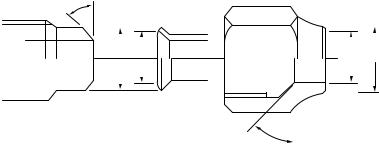
Table 3-2-6 Flare and flare nut dimensions for R22
Nominal |
Outer diameter |
|
|
|
Thickness |
|
|
Dimension (mm) |
|
|
|
|
|
Flare nut width |
||||||||||||||||
|
|
|
|
|
|
|
|
|
|
|
|
|
|
|
|
|
||||||||||||||
diameter |
|
(mm) |
|
|
|
|
|
|
|
|
(mm) |
|
A |
|
B |
|
C |
|
D |
(mm) |
||||||||||
|
|
|
|
|
|
|
|
|
|
|
|
|
|
|
|
|
|
|
|
|
||||||||||
|
|
|
|
|
|
|
|
|
|
|
|
|
|
|
|
|
|
|||||||||||||
1/4 |
6.35 |
|
|
|
|
|
|
0.8 |
|
9.0 |
|
9.2 |
6.5 |
|
|
13 |
17 |
|||||||||||||
|
|
|
|
|
|
|
|
|
|
|
|
|
|
|
|
|
|
|||||||||||||
3/8 |
9.52 |
|
|
|
|
|
|
0.8 |
|
13.0 |
|
13.5 |
9.7 |
|
|
20 |
22 |
|||||||||||||
|
|
|
|
|
|
|
|
|
|
|
|
|
|
|
|
|
|
|||||||||||||
1/2 |
12.70 |
|
|
|
|
|
|
0.8 |
|
16.2 |
|
16.0 |
12.9 |
|
|
20 |
24 |
|||||||||||||
|
|
|
|
|
|
|
|
|
|
|
|
|
|
|
|
|
|
|||||||||||||
5/8 |
15.88 |
|
|
|
|
|
|
1.0 |
|
19.7 |
|
19.0 |
16.0 |
|
|
23 |
27 |
|||||||||||||
|
|
|
|
|
|
|
|
|
|
|
|
|
|
|
|
|
|
|||||||||||||
3/4 |
19.05 |
|
|
|
|
|
|
1.0 |
|
23.3 |
|
24.0 |
19.2 |
|
|
34 |
36 |
|||||||||||||
|
|
|
|
|
|
|
|
|
|
|
|
|
|
|
|
|
|
|
|
|
|
|
|
|
|
|
|
|
|
|
|
|
to |
46˚ |
|
|
|
|
|
|
|
|
|
|
|
|
|
|
|
|
|
|
|
|
|
|
|||||
|
|
|
|
|
|
|
|
|
|
|
|
|
|
|
|
|
|
|
|
|
|
|
|
|
|
|
|
|
|
|
|
|
45˚ |
|
|
|
|
|
|
|
|
|
|
|
|
|
|
|
|
|
|
|
|
|
|
|
|
|
|
|
|
|
|
|
|
|
|
|
|
|
|
|
|
|
|
|
|
|
|
|
|
|
|
|
|
|
|
|
|
|
|
|
|
|
|
|
|
|
|
|
|
|
|
|
|
|
|
|
|
|
|
|
|
|
|
|
|
|
|
|
|
||
|
|
|
|
|
|
|
|
|
|
|
|
|
|
|
|
|
|
|
|
|
|
|
|
|
|
|
|
|
|
|
|
|
|
|
|
|
|
B |
|
A |
|
|
|
|
|
|
|
|
|
|
|
C |
|
|
D |
|
|
||||
|
|
|
|
|
|
|
|
|
|
|
|
|
||||||||||||||||||
|
|
|
|
|
|
|
|
|
|
|
|
|
|
|
|
|
|
|
|
|
|
|
|
|
|
|
|
|
|
|
|
|
|
|
|
|
|
|
|
|
|
|
|
43˚ |
to |
|
|
|
|
|
|
|
45˚ |
||
Fig. 3-2-2 Relations between flare nut and flare seal surface
2.Flare Connecting Procedures and Precautions
a)Make sure that the flare and union portions do not have any scar or dust, etc.
b)Correctly align the processed flare surface with the union axis.
c)Tighten the flare with designated torque by means of a torque wrench. The tightening torque for R410A is the same as that for conventional R22. Incidentally, when the torque is weak, the gas leakage may occur.
When it is strong, the flare nut may crack and may be made non-removable. When choosing the tightening torque, comply with values designated by manufacturers. Table 3-2-7 shows reference values.
NOTE :
When applying oil to the flare surface, be sure to use oil designated by the manufacturer.
If any other oil is used, the lubricating oils may deteriorate and cause the compressor to burn out.
Table 3-2-7 Tightening torque of flare for R410A [Reference values]
Nominal |
Outer diameter |
Tightening torque |
Tightening torque of torque |
|
wrenches available on the market |
||||
diameter |
(mm) |
N•m (kgf•cm) |
||
N•m (kgf•cm) |
||||
|
|
|
||
|
|
|
|
|
1/4 |
6.35 |
14 to 18 (140 to 180) |
16 (160), 18 (180) |
|
|
|
|
|
|
3/8 |
9.52 |
33 to 42 (330 to 420) |
42 (420) |
|
|
|
|
|
|
1/2 |
12.70 |
50 to 62 (500 to 620) |
55 (550) |
|
|
|
|
|
|
5/8 |
15.88 |
63 to 77 (630 to 770) |
65 (650) |
|
|
|
|
|
– 10 –

3-3. Tools
3-3-1. Required Tools
The service port diameter of packed valve of the outdoor unit in the air-water heat pump using R410A is changed to prevent mixing of other refrigerant. To reinforce the pressure-resisting strength, flare processing dimensions and opposite side dimension of flare nut (For Ø12.7 copper pipe) of the refrigerant piping are lengthened.
The used refrigerating oil is changed, and mixing of oil may cause a trouble such as generation of sludge, clogging of capillary, etc. Accordingly, the tools to be used are classified into the following three types.
1.Tools exclusive for R410A (Those which cannot be used for conventional refrigerant (R22))
2.Tools exclusive for R410A, but can be also used for conventional refrigerant (R22)
3.Tools commonly used for R410A and for conventional refrigerant (R22)
The table below shows the tools exclusive for R410A and their interchangeability.
Tools exclusive for R410A (The following tools for R410A are required.)
Tools whose specifications are changed for R410A and their interchangeability
|
|
|
R410A |
Conventional air-water |
||
|
|
|
air-water heat pump installation |
heat pump installation |
||
No. |
Used tool |
Usage |
|
|
|
|
Existence of |
Whether conven- |
Whether new equipment |
||||
|
|
|
||||
|
|
|
new equipment |
tional equipment |
can be used with |
|
|
|
|
for R410A |
can be used |
conventional refrigerant |
|
|
|
|
|
|
|
|
1 |
Flare tool |
Pipe flaring |
Yes |
*(Note 1) |
¡ |
|
|
|
|
|
|
|
|
|
Copper pipe gauge for |
Flaring by |
|
*(Note 1) |
*(Note 1) |
|
2 |
adjusting projection |
Yes |
||||
conventional flare tool |
||||||
|
margin |
|
|
|
||
|
|
|
|
|
||
|
|
|
|
|
|
|
3 |
Torque wrench |
Connection of flare nut |
Yes |
× |
× |
|
(For Ø12.7) |
||||||
|
|
|
|
|
|
|
4 |
Gauge manifold |
Evacuating, refrigerant |
Yes |
× |
× |
|
|
|
|||||
5 |
Charge hose |
charge, run check, etc. |
||||
|
|
|
|
|||
|
|
|
|
|
|
|
6 |
Vacuum pump adapter |
Vacuum evacuating |
Yes |
× |
¡ |
|
7 |
Electronic balance for |
Refrigerant charge |
Yes |
× |
¡ |
|
refrigerant charging |
||||||
|
|
|
|
|
|
|
8 |
Refrigerant cylinder |
Refrigerant charge |
Yes |
× |
× |
|
9 |
Leakage detector |
Gas leakage check |
Yes |
× |
¡ |
|
10 |
Charging cylinder |
Refrigerant charge |
(Note 2) |
× |
× |
|
(Note 1) When flaring is carried out for R410A using the conventional flare tools, adjustment of projection margin is necessary. For this adjustment, a copper pipe gauge, etc. are necessary.
(Note 2) Charging cylinder for R410A is being currently developed.
General tools (Conventional tools can be used.)
In addition to the above exclusive tools, the following equipments which serve also for R22 are necessary as the general tools.
1.Vacuum pump
Use vacuum pump by attaching vacuum pump adapter.
2.Torque wrench (For Ø6.35, Ø9.52)
3.Pipe cutter
4. |
Reamer |
9. |
Hole core drill (Ø65) |
5. |
Pipe bender |
10. |
Hexagon wrench |
6. |
Level vial |
|
(Opposite side 4mm) |
7. |
Screwdriver (+, –) |
11. |
Tape measure |
|
|
||
8. |
Spanner or Monkey wrench |
12. |
Metal saw |
Also prepare the following equipments for other installation method and run check.
1. |
Clamp meter |
3. |
Insulation resistance tester |
2. |
Thermometer |
4. |
Electroscope |
– 11 –
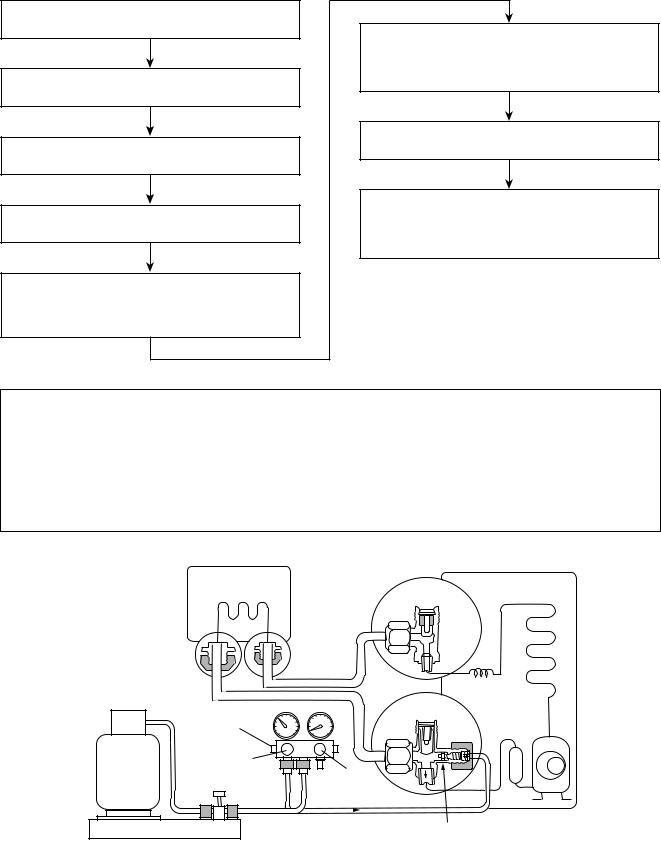
3-4. Recharging of Refrigerant
When it is necessary to recharge refrigerant, charge the specified amount of new refrigerant according to the following steps.
Recover the refrigerant, and check no refrigerant remains in the equipment.
Connect the charge hose to packed valve service port at the outdoor unit’s gas side.
Connect the charge hose to the vacuum pump adapter.
Open fully both packed valves at liquid and gas sides.
Place the handle of the gauge manifold Low in the fully opened position, and turn on the vacuum pump’s power switch. Then, evacuating the refrigerant in the cycle.
When the compound gauge’s pointer has indicated –0.1 Mpa (–76 cmHg), place the handle Low in the fully closed position, and turn off the vacuum pump’s power switch.
Keep the status as it is for 1 to 2 minutes, and ensure that the compound gauge’s pointer does not return.
Set the refrigerant cylinder to the electronic balance, connect the connecting hose to the cylinder and the connecting port of the electronic balance, and charge liquid refrigerant.
(For refrigerant charging, see the figure below.)
1.Never charge refrigerant exceeding the specified amount.
2.If the specified amount of refrigerant cannot be charged, charge refrigerant bit by bit in COOL mode.
3.Do not carry out additional charging.
When additional charging is carried out if refrigerant leaks, the refrigerant composition changes in the refrigeration cycle, that is characteristics of the air conditioner changes, refrigerant exceeding the specified amount is charged, and working pressure in the refrigeration cycle becomes abnormally high pressure, and may cause a rupture or personal injury.
(Water heat
(Outdoor unit)
exchanger unit)
|
Opened |
|
Refrigerant cylinder |
|
|
(with siphon) |
|
|
Check valve |
Opened |
|
|
||
Opened |
|
|
Open/close |
Closed |
|
valve for charging |
||
|
||
|
Service port |
|
Electronic balance for refrigerant charging |
|
Fig. 3-4-1 Configuration of refrigerant charging
– 12 –
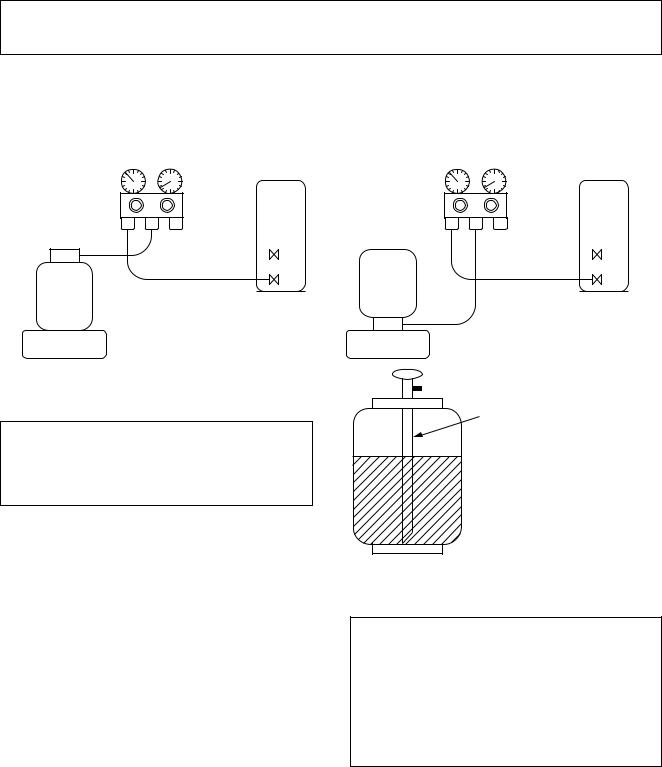
1.Be sure to make setting so that liquid can be charged.
2.When using a cylinder equipped with a siphon, liquid can be charged without turning it upside down.
It is necessary for charging refrigerant under condition of liquid because R410A is mixed type of refrigerant. Accordingly, when charging refrigerant from the refrigerant cylinder to the equipment, charge it turning the cylinder upside down if cylinder is not equipped with siphon.
[ Cylinder with siphon ] |
[ Cylinder without siphon ] |
Gauge manifold |
Gauge manifold |
OUTDOOR unit |
OUTDOOR unit |
Refrigerant
cylinder
Electronic
balance
R410A refrigerant is HFC mixed refrigerant. Therefore, if it is charged with gas, the composition of the charged refrigerant changes and the characteristics of the equipment varies.
cylinder Refrigerant
Electronic
balance
Siphon
Fig. 3-4-2
3-5. Brazing of Pipes
3-5-1. Materials for Brazing
1.Silver brazing filler
Silver brazing filler is an alloy mainly composed of silver and copper. It is used to join iron, copper or copper alloy, and is relatively expensive though it excels in solderability.
2.Phosphor bronze brazing filler
Phosphor bronze brazing filler is generally used to join copper or copper alloy.
3.Low temperature brazing filler
Low temperature brazing filler is generally called solder, and is an alloy of tin and lead. Since it is weak in adhesive strength, do not use it for refrigerant pipes.
1.Phosphor bronze brazing filler tends to react with sulfur and produce a fragile compound water solution, which may cause a gas leakage. Therefore, use any other type of brazing filler at a hot spring resort, etc., and coat the surface with a paint.
2.When performing brazing again at time of servicing, use the same type of brazing filler.
3-5-2. Flux
1.Reason why flux is necessary
•By removing the oxide film and any foreign matter on the metal surface, it assists the flow of brazing filler.
•In the brazing process, it prevents the metal surface from being oxidized.
•By reducing the brazing filler’s surface tension, the brazing filler adheres better to the treated metal.
– 13 –
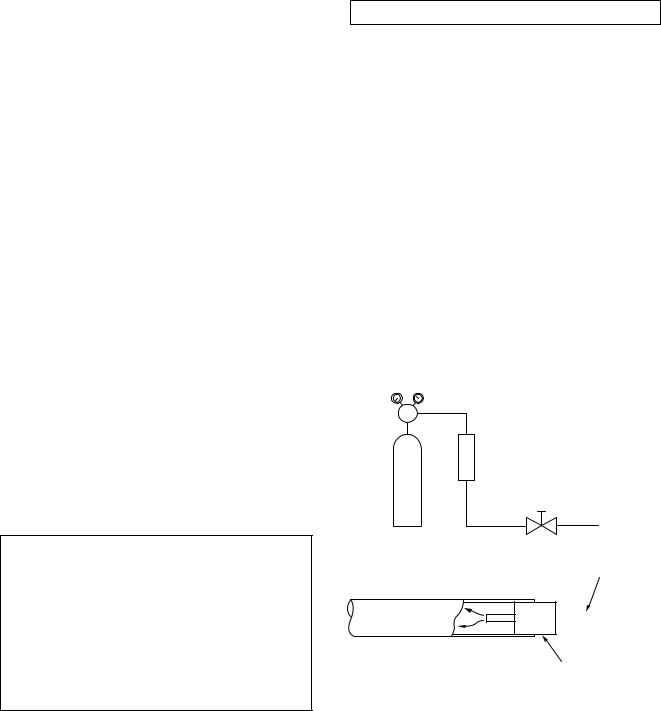
2.Characteristics required for flux
•Activated temperature of flux coincides with the brazing temperature.
•Due to a wide effective temperature range, flux is hard to carbonize.
•It is easy to remove slag after brazing.
•The corrosive action to the treated metal and brazing filler is minimum.
•It excels in coating performance and is harmless to the human body.
As the flux works in a complicated manner as described above, it is necessary to select an adequate type of flux according to the type and shape of treated metal, type of brazing filler and brazing method, etc.
3.Types of flux
•Noncorrosive flux
Generally, it is a compound of borax and boric acid.
It is effective in case where the brazing temperature is higher than 800°C.
•Activated flux
Most of fluxes generally used for silver brazing are this type.
It features an increased oxide film removing capability due to the addition of compounds such as potassium fluoride, potassium chloride and sodium fluoride to the borax-boric acid compound.
4.Piping materials for brazing and used brazing filler/flux
Piping material |
Used brazing filler |
Used flux |
|
|
|
Copper - Copper |
Phosphor copper |
Do not use |
|
|
|
Copper - Iron |
Silver |
Paste flux |
|
|
|
Iron - Iron |
Silver |
Vapor flux |
|
|
|
1.Do not enter flux into the refrigeration cycle.
2.When chlorine contained in the flux remains within the pipe, the lubricating oil deteriorates. Therefore, use a flux which does not contain chlorine.
3.When adding water to the flux, use water which does not contain chlorine (e.g. distilled water or ion-exchange water).
4.Remove the flux after brazing.
3-5-3. Brazing
As brazing work requires sophisticated techniques, experiences based upon a theoretical knowledge, it must be performed by a person qualified.
In order to prevent the oxide film from occurring in the pipe interior during brazing, it is effective to proceed with brazing while letting dry Nitrogen gas (N2) flow.
Never use gas other than Nitrogen gas.
1.Brazing method to prevent oxidation
1)Attach a reducing valve and a flow-meter to the Nitrogen gas cylinder.
2)Use a copper pipe to direct the piping material, and attach a flow-meter to the cylinder.
3)Apply a seal onto the clearance between the piping material and inserted copper pipe for Nitrogen in order to prevent backflow of the Nitrogen gas.
4)When the Nitrogen gas is flowing, be sure to keep the piping end open.
5)Adjust the flow rate of Nitrogen gas so that it is lower than 0.05 m3/Hr or 0.02 MPa (0.2kgf/cm2) by means of the reducing valve.
6)After performing the steps above, keep the Nitrogen gas flowing until the pipe cools down to a certain extent (temperature at which pipes are touchable with hands).
7)Remove the flux completely after brazing.
M Flow meter
Stop valve
Nitrogen gas cylinder
From Nitrogen cylinder
Pipe 

 Nitrogen gas
Nitrogen gas
Rubber plug
Fig. 3-5-1 Prevention of oxidation during brazing
– 14 –
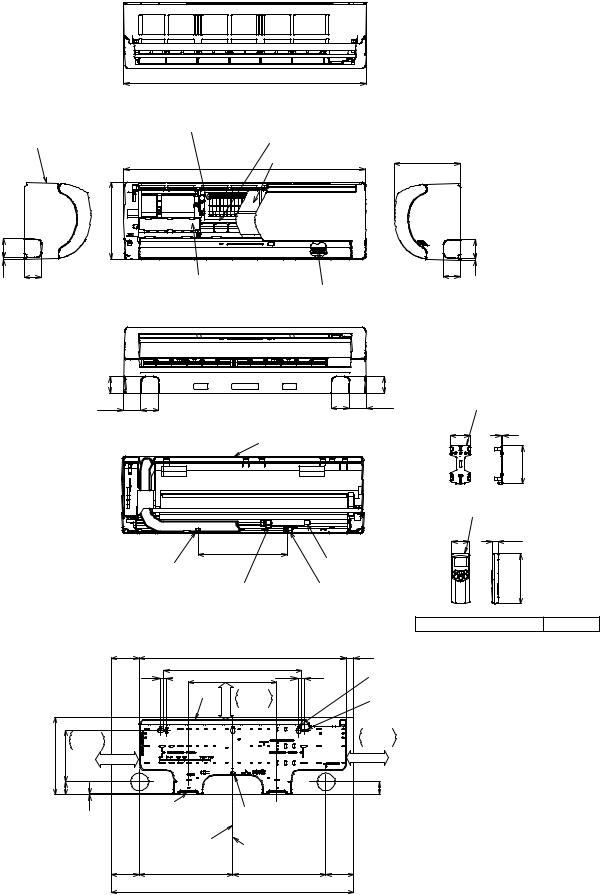
4. CONSTRUCTION VIEWS
4-1. Indoor Unit
RAS-B10GKVP-E
RAS-B13GKVP-E
RAS-B16GKVP-E
|
790 |
|
|
|
Plasma pure filter |
Indoor heat exchanger |
|
Front panel |
|
|
|
|
|
|
|
|
790 |
Air filter |
215 |
|
|
|
|
|
250 |
|
|
7 60
|
|
|
|
60 |
|
53 |
Zeolite-plus filter |
|
53 |
7 |
|
Knockout system |
Air ionizer |
Knockout system |
|||
|
|||||
53 |
|
|
53 |
54.5 |
60 |
60 |
54.5 |
Installation plate hanging section
Installation plate |
290 |
Drain hose |
hanging section |
|
(Outside length:0.54m) |
Connecting pipe |
Connecting pipe |
|
(Outside length:0.45m) |
||
(Outside length:0.4m) |
||
Flare Ø6.35 |
||
Flare Ø9.52 |
||
|
||
(RAS-B16GKVP-E : Ø12.7) |
|
Remote controller holder
64 5
125.5
Wireless remote controller
58 19
163
Parts name of remote controller WH-H03JE
250 |
167.5 |
|
42 |
91
Minimum distance to wall
140 or more
3
91
|
|
674 |
|
|
25 |
|
10 |
10 |
450 |
10 |
10 |
Stud bolt hole |
|
288 |
for Ø6 |
|||||
|
Hanging |
more |
Minimum |
|
Stud bolt hole |
|
|
section |
|
||||
|
distance |
|
||||
|
|
or |
to ceilinfg |
|
for Ø8 to Ø10 |
|
|
|
47 |
|
|
|
|
|
|
|
|
|
|
|
|
|
|
|
|
|
Minimum |
|
|
|
|
|
|
distance |
|
|
|
|
|
|
to wall |
|
|
|
|
|
|
74 or more |
|
|
|
|
|
|
42 |
Lower part |
|
|
Outline of |
|
|
|
hanging section |
|
|
|
|
||
|
|
installation plate |
|
|||
|
|
|
|
|
||
|
Center line |
|
|
Center line of |
|
|
|
of main unit |
|
|
|
|
|
|
|
|
installation plate |
|
||
|
|
|
|
|
||
|
304 |
|
|
304 |
|
91 |
|
|
790 |
|
|
|
|
– 15 –
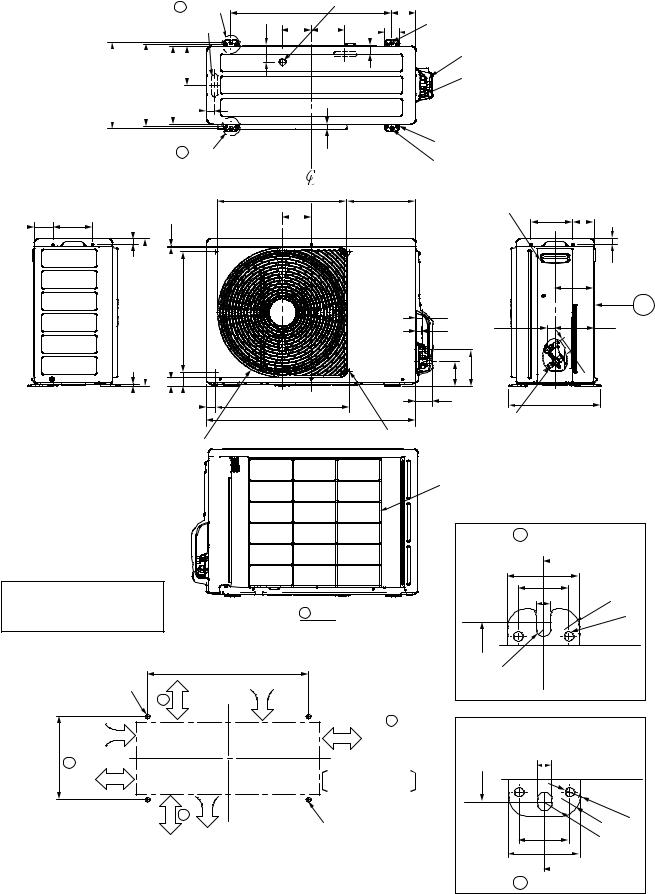
4-2. Outdoor Unit
RAS-10GAVP-E, RAS-13GAVP-E, RAS-16GAVP-E
A leg part
2-Ø20x88 drain long hole
320 |
(Anchorbort longhole pitch) 306 |
Ø7hole pitch |
290 |
|
145.5 |
|
|
|
|
||||||
|
30 |
||||||
|
|
|
|
|
|||
|
|
|
|
|
|
|
|
|
|
|
|
|
|
|
|
B leg part
60
600 |
Ø25 drain hole |
90 Ø11-14U-shape hole |
||||||||
|
|
|
|
|
|
|
||||
108 |
125 |
30 |
|
54 |
|
|
|
(for Ø8-Ø10 anchor bolt) |
||
|
|
|
|
Connecting pipe port |
||||||
|
|
|
|
|
|
|
|
|
||
|
|
|
|
|
|
|
|
|
|
|
(Pipe dia. Ø9.52:RAS-10GAVP-E, RAS-13GAVP-E) Ø12.7:RAS-16GAVP-E
|
Connecting pipe port |
|
(Pipe dia. Ø6.35) |
|
8-Ø7 hole |
20 |
(for fixing outdoor unit) |
|
Ø11x14 long hole |
|
(for Ø8-Ø10 anchor bolt) |
69.5 147
21 |
6 |
550 |
483 |
|
449 |
|
|||
|
|
|
|
|
|
|
|
|
|
|
|
8 |
35 |
52 |
32 |
Fan guard
483 |
257 |
|
|
108 |
Packed valve cover |
|
|
|
157 |
79 |
|
|
|
||
|
|
|
21 |
|
|
|
145 |
|
25 |
|
Z |
|
|
|
|
|
22 |
31 |
143 |
|
|
|
|
|
93 |
137 |
54 |
|
|
|
|
500 |
71 |
342 |
|
|
|
||
780 |
|
Charging port |
|
4-Ø4.5 embossment
Fin guard
When installing the outdoor unit, leave open in at least two of
directions (A), (B), (C) and (D) Z view shown in the figure below.
|
Mounting dimensions of anchor bolt |
|
||
2-Ø11x14U- Shape hole |
600 |
|
|
|
(for Ø8-Ø10 anchor bolt) |
|
|
|
|
|
D |
50 or more |
Intake |
|
|
|
|
|
250 or more A |
|
Intake |
|
|
|
320 |
C 100 or more |
|
|
|
|
|
Outside line |
|
|
|
|
|
Minimum distance |
|
|
|
|
of product |
from wall |
|
200 or more |
B |
|
2-Ø11x14 long hole |
|
|
|
|
|
|
|
Outlet |
|
(for Ø8-Ø10 anchor bolt) |
Detailed A leg part |
|
|
600 |
|
|
54 |
|
|
38 |
|
|
11 |
R15 |
|
|
||
|
|
7hole |
|
-Ø |
|
|
2 |
|
320 |
Outside line |
|
.5 |
||
R5 |
of product |
|
11 |
Outside line |
|
320 |
of product |
|
2- |
|
|
|
|
|
|
Ø7 |
hole |
|
R15 |
|
|
|
|
|
R5. |
|
38 |
5 |
|
|
|
|
54 |
|
|
600 |
|
|
Detailed B leg part |
|
|
– 16 –
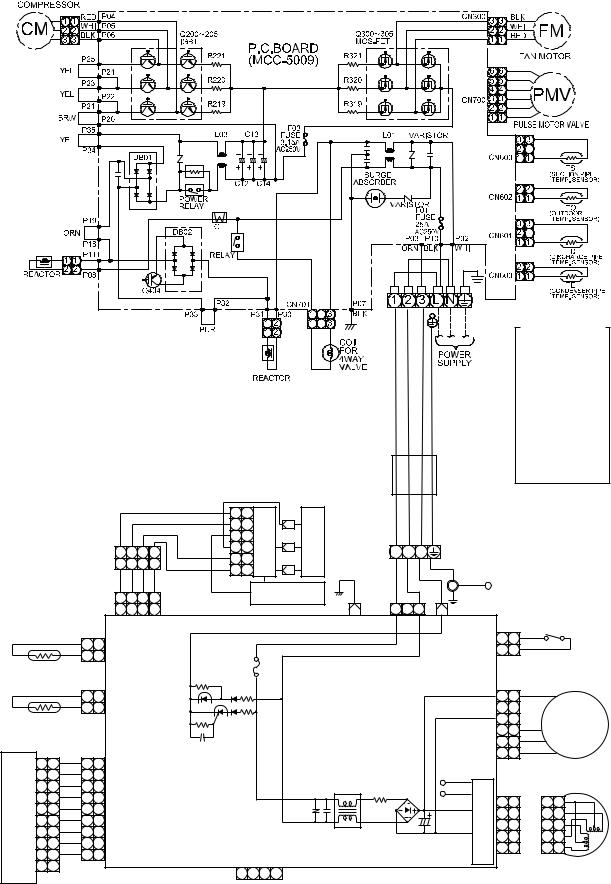
5. WIRING DIAGRAM
5-1. Outdoor Unit
RAS-10GAVP-E, RAS-13GAVP-E, RAS-16GAVP-E
|
|
Color |
|
|
|
Identification |
|
|
|
RED |
: RED |
|
|
WHI |
: WHITE |
|
220-240V ~50Hz |
BLK |
: BLACK |
|
BLU |
: BLUE |
|
|
220V ~60Hz |
||
|
BRW : BROWN |
||
|
|
||
|
|
ORN |
: ORANGE |
|
|
PUR |
: PURPUL |
|
|
YEL |
: YELLOW |
5-2. Indoor Unit |
|
GRY |
: GRAY |
|
PNK |
: PINK |
|
RAS-B10GKVP-E, RAS-B13GKVP-E, RAS-B16GKVP-E |
|
GRN& |
: GREEN& |
|
|
YEL |
YELLOW |
|
|
|
|
|
|
|
|
|
|
BLK |
|
|
|
|
|
|
|
|
|
|
|
|
|
||
|
|
|
|
|
|
|
|
|
BLK |
1 |
1 |
|
|
|
|
|
|
|
|
|
|
|
|
|
|
|
|
|
|
|
|
1 |
2 |
3 |
4 |
voltage-High Powersupply |
purifierAir |
Electrode |
BLOCK |
|
|
|
|
|
|
|
|
|
|
||
|
|
|
|
|
|
5 |
5 |
|
|
|
|
|
|
|
|
|
|
||||||||
|
|
|
|
|
|
|
|
|
|
2 |
2 |
|
|
|
|
|
|
|
|
|
|
|
|
|
|
|
|
|
|
|
|
|
|
|
|
3 |
3 |
|
|
|
INDOOR |
|
|
|
|
|
|
|
|
|
|
|
|
|
|
|
|
1 |
2 |
3 |
4 |
4 |
4 |
|
|
|
1 |
2 3 |
|
|
|
|
|
|
|
||
|
|
|
|
|
|
|
|
|
TERMINAL |
|
|
|
|
|
|
|
|||||||||
|
|
|
|
|
|
|
|
|
|
|
|
|
|
|
|
|
|
||||||||
|
|
|
|
|
|
RED |
BRW |
BRW |
BRW |
6 |
6 |
|
|
|
|
|
|
|
Heat |
|
|
|
|
|
|
|
|
|
|
|
|
|
|
|
|
|
|
|
|
|
exchanger |
|
|
|
|
|
|||||
|
|
|
|
|
|
|
|
|
|
|
|
|
|
|
|
|
|
|
|
|
|
|
|
||
|
|
|
|
|
|
1 |
2 |
3 |
4 |
|
|
Ion electrode |
|
BLK |
WHI |
RED |
GRN & YEL |
|
|
|
|
||||
|
|
|
|
|
|
|
|
|
|
|
|
|
|
|
|
|
|
||||||||
|
|
|
|
|
|
1 |
2 |
3 |
4 |
|
|
|
|
|
|
3 |
1 |
|
|
|
|
|
|
|
|
|
|
|
|
CN01 |
|
CN33 |
|
|
|
|
|
CN22 |
CN23 |
|
CN21 |
|
|
|
|
|
|
||||
|
|
|
|
|
(WHI) |
|
|
|
|
|
|
|
|
|
|
|
|
|
|
|
|
||||
|
|
|
BLK |
(BLU) |
|
|
|
|
|
|
|
|
|
|
|
|
1 |
1 |
BRW |
|
|
||||
|
|
|
|
|
|
|
|
|
|
|
|
|
|
|
|
|
|
|
|
||||||
|
|
|
1 |
1 |
|
|
|
|
FUSE |
|
|
|
|
|
|
|
|
CN34 |
|
Micro SW |
|||||
|
|
|
BLK |
|
|
|
|
|
|
|
|
|
|
|
|
2 |
2 |
|
|
||||||
|
|
|
2 |
2 |
|
|
|
|
|
|
|
|
|
|
|
|
BLU |
||||||||
|
|
|
|
|
|
|
F01 |
|
|
|
|
|
|
|
|
|
|
||||||||
HEAT EXCHANGER |
|
|
|
|
|
AC 250V |
|
|
|
|
|
|
|
|
|
(RED) |
|
|
|
||||||
SENSOR (TC) |
CN03 |
|
|
|
|
T3.15A |
|
|
|
|
|
|
|
|
|
CN10 |
|
FAN MOTOR |
|||||||
|
|
|
|
(WHI) |
|
|
|
|
|
|
|
|
|
|
|
|
|
|
|
(WHI) |
|
||||
|
|
|
BLK |
1 |
1 |
|
|
|
|
|
|
|
|
|
|
|
|
|
|
|
1 |
1 |
RED |
|
|
|
|
|
BLK |
2 |
2 |
|
|
|
|
|
|
|
|
|
|
|
|
|
|
|
|
|
BLK |
|
|
THERMO SENSOR |
|
|
|
|
|
|
|
|
|
|
|
|
|
|
|
|
|
3 |
3 |
|
|
||||
|
(TA) |
|
|
|
|
|
|
|
|
|
|
|
|
|
|
|
|
|
|
|
4 |
4 |
WHI |
|
DC MOTOR |
|
CN100 |
|
CN13 |
|
|
|
|
|
|
|
|
|
|
|
|
|
|
|
5 |
5 |
YEL |
|
|
||
AssemblyUnitWireless |
(WHI) |
BLU |
(WHI) |
|
|
|
|
|
|
|
|
|
|
|
|
|
|
|
6 |
6 |
BLU |
|
|
||
1 |
1 |
9 |
9 |
|
|
|
|
|
|
|
|
|
|
|
|
|
SUPPLYPOWER |
CIRCUIT |
|
|
|
|
|
||
2 |
2 |
BLUBLU 8 8 |
|
|
|
|
|
|
|
|
|
|
|
|
|
|
|
|
|
|
|||||
|
|
|
|
|
|
|
|
|
|
LINE |
|
|
|
DC5V |
|
CN07 |
|
|
|
||||||
|
3 |
3 |
|
7 |
7 |
|
|
|
|
|
|
|
|
|
FILTER |
DB01 |
|
|
|
(WHI) |
|
|
|
||
|
4 |
4 |
BLUBLU 6 6 |
|
|
|
|
|
|
|
|
|
|
|
|
|
WHI |
|
|
||||||
|
|
|
|
|
|
|
|
|
|
|
|
DC12V |
|
1 |
1 |
1 |
1 |
||||||||
|
5 |
5 |
BLU |
5 |
5 |
|
|
|
|
|
|
|
|
|
|
|
|
|
|
|
2 |
2 |
YEL |
2 |
2 |
|
6 |
6 |
BLU |
4 |
4 |
|
|
|
|
|
|
|
TNR |
|
|
|
|
|
|
3 |
3 |
YEL |
3 |
3 |
|
|
7 |
7 |
BLU |
3 |
3 |
MAIN P.C. BOARD |
|
|
|
|
|
|
|
|
|
|
|
4 |
4 |
YEL |
4 |
4 |
|||
|
8 |
8 |
WHI |
2 |
2 |
|
|
|
|
|
|
|
|
|
|
|
5 |
5 |
YEL |
5 |
5 |
||||
|
9 |
9 |
|
1 |
1 |
|
(MCC-5020) |
CN08 (WHI) |
|
|
|
|
|
|
|
|
|
LOUVER MOTOR |
|||||||
MCC-899 10 10 |
|
|
|
|
|
|
|
|
|
|
|
|
|
|
|
|
|||||||||
|
|
|
|
|
|
|
1 |
2 |
3 |
4 |
|
|
|
|
|
|
|
|
|
||||||
|
|
|
|
|
|
|
|
|
|
|
|
|
|
|
|
|
|
|
|
|
|
||||
|
|
|
|
|
|
|
|
|
|
|
|
|
– 17 – |
|
|
|
|
|
|
|
|
|
|
|
|
6. SPECIFICATIONS OF ELECTRICAL PARTS
6-1. Indoor Unit
RAS-B10GKVP-E, RAS-B13GKVP-E, RAS-B16GKVP-E
No. |
Parts name |
Type |
|
Specifications |
|
|
|
|
|
1 |
Fan motor (for indoor) |
MF-280-30-5R |
DC280–340V, 30W |
|
|
|
|
|
|
2 |
Room temp. sensor (TA-sensor) |
( – ) |
10kΩ |
at 25°C |
|
|
|
|
|
3 |
Heat exchanger temp. sensor (TC-sensor) |
( – ) |
10kΩ |
at 25°C |
|
|
|
|
|
4 |
Louver motor |
MP24Z |
Output (Rated) 1W, 16 poles, DC12V |
|
|
|
|
|
|
6-2. Outdoor Unit
RAS-10GAVP-E, RAS-13GAVP-E, RAS-16GAVP-E
No. |
Parts name |
Model name |
|
Rating |
|
|
|
|
|
1 |
Reactor |
CH-57 |
L = 10mH, 16A × 2 |
|
|
|
|
|
|
2 |
Outside fan motor |
ICF-140-43-4R |
DC140V, 43W |
|
|
|
|
|
|
3 |
Suction temp. sensor (TS sensor) |
(Inverter attached) |
10kΩ |
(25°C) |
|
|
|
|
|
4 |
Discharge temp. sensor (TD sensor) |
(Inverter attached) |
62kΩ |
(20°C) |
|
|
|
|
|
5 |
Outside air temp. sensor (TO sensor) |
(Inverter attached) |
10kΩ |
(25°C) |
|
|
|
|
|
6 |
Heat exchanger temp. sensor (TE sensor) |
(Inverter attached) |
10kΩ |
(25°C) |
|
|
|
|
|
7 |
Terminal block (6P) |
—— |
20A, AC250V |
|
|
|
|
|
|
8 |
Compressor |
DA111A1F-20F1 |
3-phases 4-poles 750W |
|
|
|
|
|
|
9 |
Coil for P.M.V. |
CAM-MD12TF |
DC12V |
|
|
|
|
|
|
10 |
Coil for 4-way valve |
VHV |
AC220–240V |
|
|
|
|
|
|
– 18 –
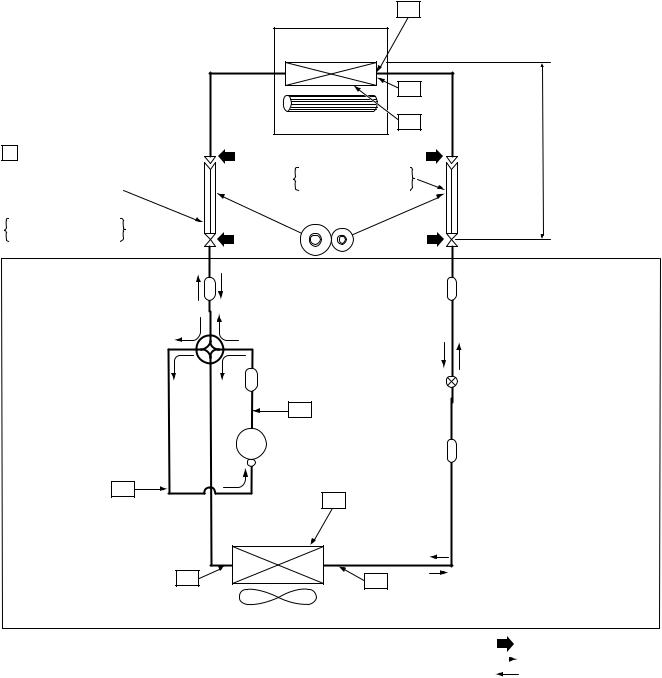
7. REFRIGERANT CYCLE DIAGRAM
7-1. Refrigerant Cycle Diagram
RAS-B10GKVP-E/RAS-10GAVP-E
P Pressure measurement
Gauge attaching port
Vacuum pump connecting port
Deoxidized copper pipe Outer dia. : 9.52mm Thickness : 0.8mm
INDOOR UNIT |
T1 |
Temp. measurement |
|
|
|
|
|
|
|
|
|
||
Indoor heat |
|
|
|
|
|
|
exchanger |
|
|
|
|
|
|
|
TC |
heightAllowable 10m:difference |
lengthpipeAllowable |
|
|
|
Cross flow fan |
TA |
Max. |
: 25m |
|||
|
|
|||||
|
|
|
|
|||
|
|
|
|
Min. |
: 2m |
|
Deoxidized copper pipe |
|
|
Chargeless : 15m |
|||
Outer dia. : 6.35mm |
|
|
Charge : 20g/m |
|||
Thickness : 0.8mm |
|
|
|
(16 to 25m) |
||
Sectional shape |
|
|
|
|
|
|
of heat insulator |
|
|
|
|
|
|
Muffler |
Strainer |
4-way valve (STF-0108Z)
Muffler |
Pulse motor |
|
valve at liquid side |
||
|
||
TD |
(CAM-B22YGTF-3) |
|
|
||
Compressor |
Strainer |
|
DA111A1F-20F1 |
TS
TO
Outdoor heat exchanger
Temp. measurement T2 |
TE |
Propeller fan |
|
Refrigerant amount : 0.82kg |
|
OUTDOOR UNIT |
NOTE : |
|
Gas leak check position |
|
|
|
Refrigerant flow (Cooling) |
|
|
|
|
|
|
|
Refrigerant flow (Heating) |
NOTE :
•The maximum pipe length of this air conditioner is 25 m. When the pipe length exceeds 15m, the additional charging of refrigerant, 20g per 1m for the part of pipe exceeded 15m is required. (Max. 200g)
–19 –
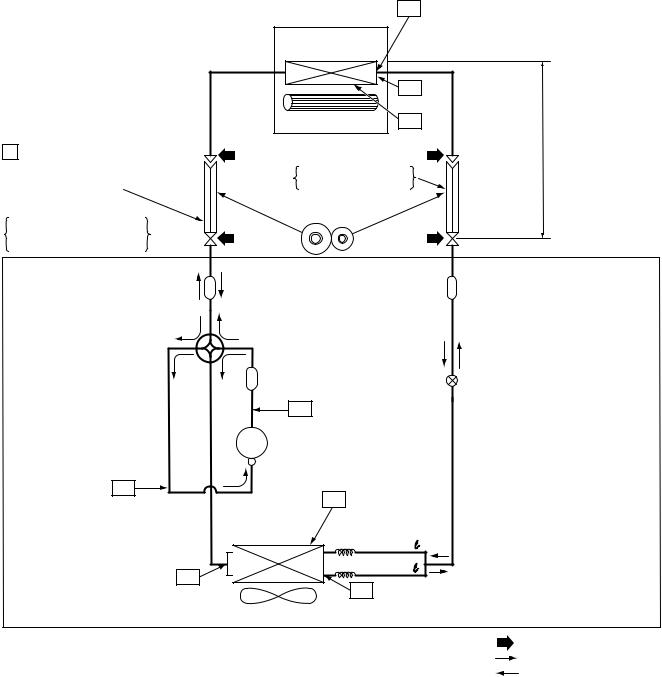
RAS-B13GKVP-E/RAS-13GAVP-E, RAS-B16GKVP-E/RAS-16GAVP-E
|
INDOOR UNIT |
T1 |
Temp. measurement |
|
|
|
|
|
|
|
|
|
|
|
Indoor heat |
|
|
|
|
|
|
exchanger |
|
|
|
|
|
|
|
TC |
heightAllowable 10m:difference |
lengthpipeAllowable |
|
|
|
Cross flow fan |
TA |
Max. |
: 25m |
||
|
|
|
||||
|
|
|
|
|
||
P Pressure measurement |
|
|
|
|
Min. |
: 2m |
Deoxidized copper pipe |
|
|
Chargeless : 15m |
|||
Gauge attaching port |
|
|
||||
Outer dia. : 6.35mm |
|
|
Charge : 20g/m |
|||
Vacuum pump connecting port |
Thickness : 0.8mm |
|
|
|
(16 to 25m) |
|
Deoxidized copper pipe |
Sectional shape |
|
|
|
|
|
of heat insulator |
|
|
|
|
|
|
Outer dia. : 9.52mm(13), |
|
|
|
|
|
|
|
|
|
|
|
|
|
12.7mm(16) |
|
|
|
|
|
|
Thickness : 0.8mm |
|
|
|
|
|
|
|
Muffler |
|
Strainer |
|
4-way valve |
|
|
|
|
(STF-0108Z) |
|
|
|
|
|
Muffler |
|
Pulse motor |
|
|
|
valve at liquid side |
||
|
|
|
||
|
TD |
|
(CAM-B22YGTF-3) |
|
|
|
|
|
|
|
Compressor |
|
|
|
|
DA111A1F-20F1 |
|
|
|
TS |
|
TO |
|
|
|
|
|
|
|
|
Outdoor heat |
Split capillary |
|
|
|
exchanger |
|
|
|
|
Ø1.2 x 80 |
|
|
|
|
|
|
|
|
Temp. measurement |
T2 |
Ø1.2 x 80 |
|
|
|
|
|
||
|
|
TE |
|
|
|
Propeller fan |
|
|
Refrigerant amount : 0.96kg |
|
OUTDOOR UNIT |
NOTE : |
Gas leak check position |
|
|
|
|
|
Refrigerant flow (Cooling) |
|
|
|
|
Refrigerant flow (Heating) |
NOTE :
•The maximum pipe length of this air conditioner is 25 m. When the pipe length exceeds 15m, the additional charging of refrigerant, 20g per 1m for the part of pipe exceeded 15m is required. (Max. 200g)
–20 –
7-2. Operation Data
<Cooling>
Temperature |
|
Standard |
Heat exchanger |
|
|
Compressor |
|||
condition (°C) |
Model name |
pipe temp. |
Indoor |
Outdoor |
|||||
pressure |
revolution |
||||||||
|
|
RAS- |
|
|
fan mode |
fan mode |
|||
Indoor |
Outdoor |
P (MPa) |
T1 (°C) |
T2 (°C) |
(rps) |
||||
|
|
|
|||||||
|
|
|
|
|
|||||
|
|
|
|
|
|
|
|
|
|
|
|
B10GKVP-E |
0.9 to 1.1 |
13 to 15 |
42 to 44 |
High |
High |
37 |
|
|
|
|
|
|
|
|
|
|
|
27/19 |
35/– |
B13GKVP-E |
0.8 to 1.0 |
11 to 14 |
42 to 45 |
High |
High |
59 |
|
|
|
|
|
|
|
|
|
|
|
|
|
B16GKVP-E |
0.7 to 0.9 |
8 to 11 |
43 to 47 |
High |
High |
82 |
|
|
|
|
|
|
|
|
|
|
|
<Heating>
Temperature |
|
Standard |
Heat exchanger |
|
|
Compressor |
|||
condition (°C) |
Model name |
pipe temp. |
Indoor |
Outdoor |
|||||
pressure |
revolution |
||||||||
|
|
RAS- |
|
|
fan mode |
fan mode |
|||
Indoor |
Outdoor |
P (MPa) |
T1 (°C) |
T2 (°C) |
(rps) |
||||
|
|
|
|||||||
|
|
|
|
|
|||||
|
|
|
|
|
|
|
|
|
|
|
|
B10GKVP-E |
2.2 to 2.4 |
37 to 39 |
0 to 3 |
High |
High |
54 |
|
|
|
|
|
|
|
|
|
|
|
20/– |
7/6 |
B13GKVP-E |
2.5 to 2.7 |
42 to 45 |
0 to 2 |
High |
High |
65 |
|
|
|
|
|
|
|
|
|
|
|
|
|
B16GKVP-E |
2.8 to 3.0 |
48 to 49 |
0 to 2 |
High |
High |
86 |
|
|
|
|
|
|
|
|
|
|
|
NOTES :
1.Measure surface temperature of heat exchanger pipe around center of heat exchanger path U bent. (Thermistor themometer)
2.Connecting piping condition : 7.5 m
– 21 –
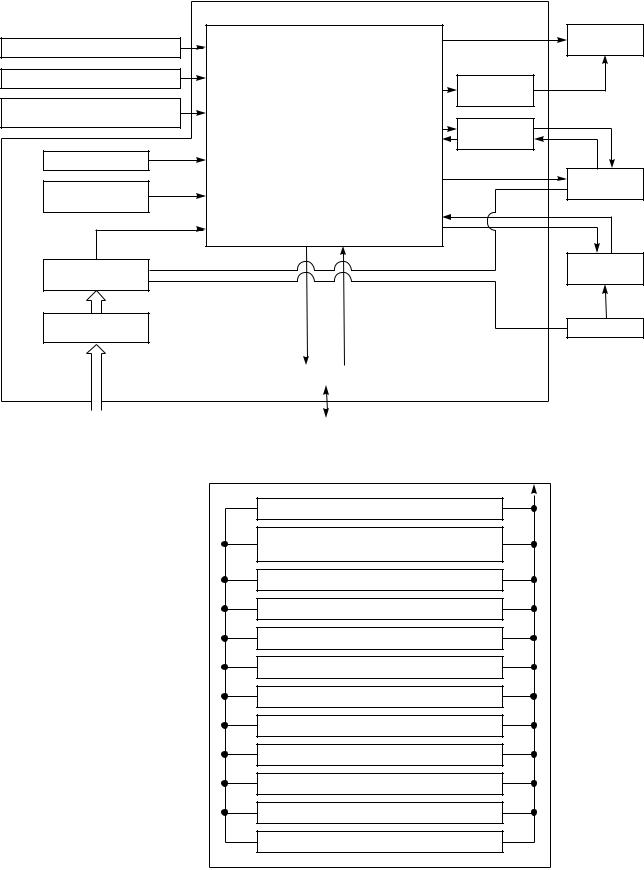
8. CONTROL BLOCK DIAGRAM
8-1. Indoor Unit
RAS-B10GKVP-E, RAS-B13GKVP-E, RAS-B16GKVP-E
M.C.U. |
Indoor Unit Control Unit |
|
|
Functions |
Louver |
|
Heat Exchanger Sensor (Tc) |
Motor |
||
|
|||
Room Temperature Sensor (Ta) |
• Cold draft preventing Function |
|
|
• 3-minute Delay at Restart for Compressor |
Louver Motor |
||
|
|||
|
Drive Control |
||
Infrared Rays Signal Receiver |
|
||
• Fan Motor Starting Control |
|
||
and Indication |
Indoor Fan |
||
|
|||
|
|
||
|
• Processing |
Motor Control |
|
Initializing Circuit |
(Temperature Processing) |
|
|
|
|
||
Clock Frequency |
• Timer |
Indoor |
|
|
Fan Motor |
||
Oscillator Circuit |
• Serial Signal Communication |
|
|
|
|
||
|
• Clean Function |
|
|
Power Supply |
|
Air purifier |
|
|
unit |
||
Circuit |
|
||
|
|
||
Converter |
|
Micro Switch |
|
(D.C circuit) |
|
||
|
|
|
Noise Filter |
|
Serial Signal Transmitter/Receiver |
|
From Outdoor Unit |
|
|||
|
220-240V |
~50Hz |
Serial Signal Communication |
|
|
220V |
~60Hz |
(Operation Command and Information) |
|
Remote Controller |
Infrared Rays, 36.7kHz |
REMOTE CONTROLLER
Operation (START/STOP)
Operation Mode Selection
AUTO, COOL, DRY, HEAT
Thermo. Setting
Fan Speed Selection
ON TIMER Setting
OFF TIMER Setting
Louver AUTO Swing
Louver Direction Setting
ECO
Hi-POWER
Air Purifier
SLEEP
– 22 –
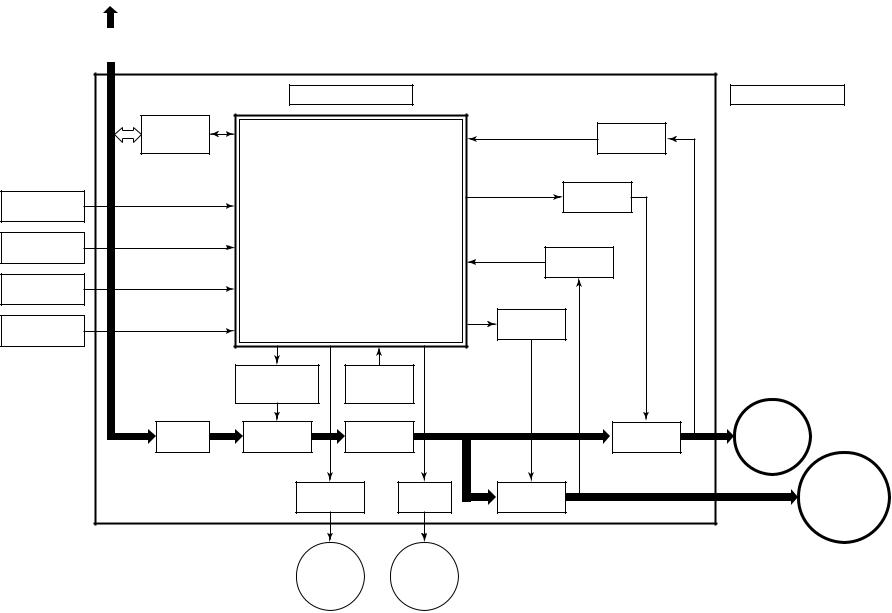
For INDOOR UNIT |
MICRO-COMPUTER BLOCK DIAGRAM |
|
|
220–240 V ~50Hz |
|
|
|
|
|
|
|
220 V ~60Hz |
|
|
|
|
|
|
|
|
|
MCC5009 (P.C.B) |
|
|
OUTDOOR UNIT |
|
|
Indoor unit |
|
|
|
|
Current |
|
|
send/receive |
|
M.C.U |
|
|
||
|
circuit |
|
|
detect |
|
||
|
|
|
|
|
|
||
|
|
• |
PWM synthesis function |
|
|
|
|
|
|
• |
Input current release control |
|
Gate drive |
|
|
|
Discharge |
• |
IGBT over-current detect control |
|
|||
|
• |
Outdoor fan control |
|
circuit |
|
||
|
temp. sensor |
|
|
|
|||
|
|
• |
High power factor correction control |
|
|
||
|
Outdoor air |
• |
Inverter output frequency control |
|
|
||
|
temp. sensor |
• |
A/D converter function |
|
Current |
|
|
|
|
|
|
||||
– |
|
• |
P.M.V. control |
|
|
detect |
|
Suction temp. |
|
|
|
|
|||
23 |
• |
Discharge temp. control |
|
|
|
||
sensor |
|
|
|
||||
|
|
|
|
||||
– |
|
• |
4-way valve control |
|
Gate drive |
|
|
|
Heat exchanger |
• |
Signal communication to indoor unit |
|
|||
|
circuit |
|
|||||
|
temp.sensor |
|
|
|
|
|
|
|
|
|
|
|
|
|
|
|
|
High Power |
Clock |
|
|
|
|
|
|
factor Correction |
frequency |
|
|
|
|
|
|
|
circuit |
4MHz |
|
|
|
|
Noise |
Input current |
Converter |
|
Inverter |
Outdoor |
|
|
Filter |
|
sensor |
(AC → DC) |
|
(DC → AC) |
Fan motor |
|
|
|
Driver circuit |
Relay |
Inverter |
Compressor |
|
|
|
|
of P.M.V. |
|
circuit |
(DC → AC) |
|
|
|
|
|
|
|||
P.M.V. : Pulse Motor Valve
M.C.U. : Micro Control Unit
4-way P.M.V. valve
RAS |
.2-8 |
-13GAVP-RAS E,-10GAVP- |
(Inverter Unit Outdoor |
16GAVP-RAS E, |
Assembly) |
E- |
|

9. OPERATION DESCRIPTION
9-1. Outline of Air Conditioner Control
This air conditioner is a capacity-variable type air conditioner, which uses DC motor for the indoor fan motor and the outdoor fan motor. And the capacityproportional control compressor which can change the motor speed in the range from 13 to 115 rps is mounted. The DC motor drive circuit is mounted to the indoor unit. The compressor and the inverter to control fan motor are mounted to the outdoor unit.
The entire air conditioner is mainly controlled by the indoor unit controller.
The indoor unit controller drives the indoor fan motor based upon command sent from the remote controller, and transfers the operation command to the outdoor unit controller.
The outdoor unit controller receives operation command from the indoor unit side, and controls the outdoor fan and the pulse motor valve. (P.M.V) Besides, detecting revolution position of the compressor motor, the outdoor unit controller controls speed of the compressor motor by controlling output voltage of the inverter and switching timing of the supply power (current transfer timing) so that motors drive according to the operation command.
And then, the outdoor unit controller transfers reversely the operating status information of the outdoor unit to control the indoor unit controller.
As the compressor adopts four-pole brushless DC motor, the frequency of the supply power from inverter to compressor is two-times cycles of the actual number of revolution.
1.Role of indoor unit controller
The indoor unit controller judges the operation commands from the remote controller and assumes the following functions.
•Judgment of suction air temperature of the indoor heat exchanger by using the indoor temp. sensor. (TA sensor)
•Judgment of the indoor heat exchanger temperature by using heat exchanger sensor (TC sensor) (Prevent-freezing control, etc.)
•Louver motor control
•Indoor fan motor operation control
•LED (Light Emitting Diode) display control
•Transferring of operation command signal (Serial signal) to the outdoor unit
•Reception of information of operation status (Serial signal including outside temp. data) to the outdoor unit and judgment/display of error
•Air purifier operation control
2.Role of outdoor unit controller
Receiving the operation command signal (Serial signal) from the indoor unit controller, the outdoor unit performs its role.
•Detection of inverter input current and current release operation
•Over-current detection and prevention operation to IGBT module (Compressor stop function)
•Compressor and outdoor fan stop function when serial signal is off (when the serial signal does not reach the board assembly of outdoor control by trouble of the signal system)
•Transferring of operation information (Serial signal) from outdoor unit controller to indoor unit controller
•Detection of outdoor temperature and operation revolution control
•Defrost control in heating operation (Temp. measurement by outdoor heat exchanger and control for 4-way valve and outdoor fan)
3.Contents of operation command signal (Serial signal) from indoor unit controller to outdoor unit controller
The following three types of signals are sent from the indoor unit controller.
•Operation mode set on the remote controller
•Compressor revolution command signal defined by indoor temperature and set temperature (Correction along with variation of room temperature and correction of indoor heat exchanger temperature are added.)
•Temperature of indoor heat exchanger
•For these signals ([Operation mode] and [Compressor revolution] indoor heat exchanger temperature), the outdoor unit controller monitors the input current to the inverter, and performs the followed operation within the range that current does not exceed the allowable value.
4.Contents of operation command signal (Serial signal) from outdoor unit controller to indoor unit controller
The following signals are sent from the outdoor unit controller.
•The current operation mode
•The current compressor revolution
•Outdoor temperature
•Existence of protective circuit operation
For transferring of these signals, the indoor unit controller monitors the contents of signals, and judges existence of trouble occurrence.
Contents of judgment are described below.
•Whether distinction of the current operation status meets to the operation command signal
•Whether protective circuit operates
When no signal is received from the outdoor unit controller, it is assumed as a trouble.
•Compressor operation control
•Operation control of outdoor fan motor
•P.M.V. control
•4-way valve control
|
Operations followed to judgment |
|
|
|
of serial signal from indoor side. |
|
– 24 –
9-2. Operation Description
9-2. |
1. |
Basic operation ........................................................................................................... |
26 |
|
|
1. Operation control ................................................................................................... |
26 |
|
|
2. Cooling/Heating operation ..................................................................................... |
27 |
|
|
3. AUTO operation ..................................................................................................... |
27 |
|
|
4. DRY operation ........................................................................................................ |
27 |
|
2. |
Indoor fan motor control ............................................................................................. |
28 |
|
3. |
Outdoor fan motor control........................................................................................... |
30 |
|
4. |
Capacity control .......................................................................................................... |
31 |
|
5. |
Current release control ............................................................................................... |
31 |
|
6. |
Release protective control by temperature of indoor heat exchanger ........................ |
32 |
|
7. |
Quick heating control .................................................................................................. |
33 |
|
8. |
Defrost control (Only in heating operation) ................................................................ |
33 |
|
9. |
Louver control ............................................................................................................. |
34 |
|
|
1) Louver position ....................................................................................................... |
34 |
|
|
2) Air direction adjustment ......................................................................................... |
34 |
|
|
3) Swing ..................................................................................................................... |
34 |
|
10. |
ECO operation ............................................................................................................ |
35 |
|
11. |
Temporary operation ................................................................................................... |
36 |
|
12. |
Air purifying control [Detection of abnormality] .......................................................... |
37 |
|
13. |
Discharge temperature control ................................................................................... |
37 |
|
14. |
Pulse motor valve (P.M.V.) control .............................................................................. |
38 |
|
15. |
Clean operation .......................................................................................................... |
39 |
|
16. |
Clean operation release ............................................................................................ |
40 |
|
17. |
Select switch on remote controller ............................................................................. |
41 |
9-3. Auto Restart Function ............................................................................................. |
42 |
|
9-3-1. |
How to Set the Auto Restart Function .................................................................... |
42 |
9-3-2. |
How to Cancel the Auto Restart Function ............................................................. |
43 |
9-3-3. |
Power Failure During Timer Operation ................................................................... |
43 |
9-4. |
FILTER Indicator ...................................................................................................... |
43 |
|
|
9-4-1. |
How to Turn Off FILTER Indicator ............................................................................ |
43 |
9-5. |
Remote Controller and Its Fuctions ...................................................................... |
44 |
|
|
9-5-1. |
Parts Name of Remote Controller ........................................................................... |
44 |
|
9-5-2. |
Name and Functions of Indications on Remote Controller ................................. |
45 |
9-6. |
Hi-POWER Mode |
|
|
|
([Hi-POWER] button on the remote controller is pressed) .................................. |
46 |
|
– 25 –
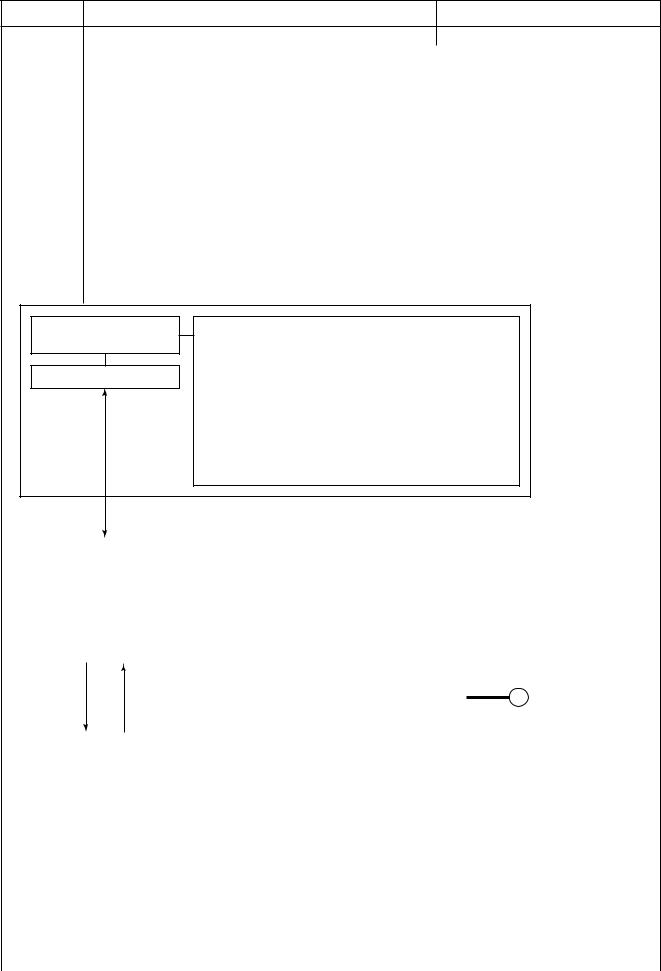
Item |
Operation flow and applicable data, etc. |
Description |
1. Basic 1. Operation control
operation
Receiving the user’s operation condition setup, the operation statuses of indoor/outdoor units are controlled.
1)The operation conditions are selected by the remote controller as shown in the below.
2)A signal is sent by ON button of the remote controller.
3)The signal is received by a sensor of the indoor unit and processed by the indoor controllers as shown in the below.
4)The indoor controller controls the indoor fan motor and louver motor.
5)The indoor controller sends the operation command to the outdoor controller, and sends/receives the control status with a serial signal.
6)The outdoor controller controls the operation as shown in the left, and also controls the compressor, outdoor fan motor, 4-way valve and pulse motor valve.
Remote controller
Selection of operation conditions
ON/OFF
Control contents of remote controller
•ON/OFF (Air conditioner/Air purifier)
•Operation select (COOL/HEAT/AUTO/DRY)
•Temperature setup
•Air direction
•Swing
•Air volume select (AUTO/LOW/LOW+/MED/MED+/HIGH)
•ECO
•ON timer setup
•OFF timer setup
•High power
Indoor unit
|
|
|
|
|
|
|
|
Signal receiving |
|
Indoor unit control |
|
|
|
|
|
|
|
|
|
|
|
|
|
|
• Command signal generating function of |
|
|
|
Indoor unit control |
|
indoor unit operation |
|
• Indoor fan motor |
|
|
|
• Calculation function (temperature calculation) |
|
|||
|
|
|
|
|
||
|
|
|
|
|
• Louver motor |
|
|
|
|
|
• Activation compensation function of indoor fan |
|
|
|
Operation command |
|
|
|
||
|
|
• Cold draft preventive function |
|
|
||
|
|
|
|
|
|
|
|
|
|
|
• Timer function |
|
|
|
Serial signal send/receive |
|
• Indoor heat exchanger release control |
|
|
|
|
|
|
|
|
|
|
|
|
|
|
|
|
|
|
|
|
|
|
|
Outdoor unit |
|
~ |
|
|
|||
|
|
|
|
|
|
|
|||||||
|
|
|
|
|
|
|
|
|
|
|
|
||
|
|
|
|
|
|
|
|
|
|
|
|
|
|
|
|
|
|
|
|
|
|
|
|
|
|
|
|
|
|
Serial signal send/receive |
|
Outdoor unit control |
Inverter |
|
|
|
|
||||
|
|
|
|
|
|
|
|||||||
|
|
|
|
|
|
• Frequency control of inverter output |
|
|
|
|
|
|
|
|
|
|
|
|
|
|
|
|
|
|
|||
|
|
Outdoor unit control |
|
• Waveform composite function |
|
|
|
|
|
|
|||
|
|
|
|
|
|
• Calculation function |
|
|
|
• Compressor |
|||
|
|
|
|
|
|
|
|||||||
|
|
|
|
|
|
(Temperature calculation) |
|
|
|
• Outdoor fan motor |
|||
|
|
|
|
|
|
• AD conversion function |
|
|
|
||||
|
|
|
|
|
|
|
|
|
• 4-way valve |
||||
|
|
|
|
|
|
• Quick heating function |
|
|
|
• Pulse motor valve |
|||
|
|
|
|
|
|
• Delay function of compressor reactivation |
|
|
|
(P.M.V.) |
|||
|
|
|
|
|
|
• Current release function |
|
|
|
|
|
|
|
|
|
|
|
|
|
• GTr over-current preventive function |
|
|
|
|
|
|
|
|
|
|
|
|
|
• Defrost operation function |
|
|
|
|
|
|
|
|
|
|
|
|
|
|
|
|
|
|
|
|
|
|
|
|
|
|
|
|
|
|
|
|
|
|
|
|
|
|
|
|
|
|
|
|
|
|
|
|
|
– 26 –
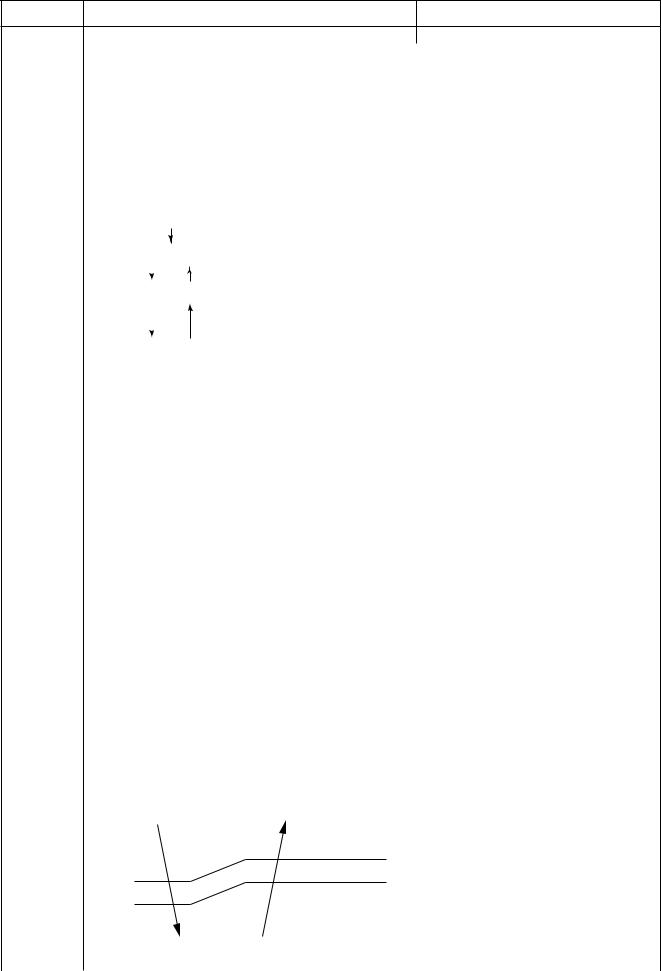
Item |
Operation flow and applicable data, etc. |
Description |
1.Basic 2. Cooling/Heating operation
operation
The operations are performed in the following parts by controls according to cooling/heating conditions.
1)Receiving the operation ON signal of the remote controller, the cooling or heating operation signal starts being transferred form the indoor controller to the outdoor unit.
2)At the indoor unit side, the indoor fan is operated according to the contents of “2. Indoor fan motor control” and the louver according to the contents of “9. Louver control”, respectively.
3)The outdoor unit controls the outdoor fan motor, compressor, pulse motor valve and 4-way valve according to the operation signal sent from the indoor unit.
*1. The power coupler of 4-way valve is usually turned off, and it is turned on during defrost operation. (Only in heating)
|
|
|
Operation ON |
|
|
Setup of remote controller |
|
|||||||||
|
|
|
|
|
||||||||||||
|
|
|
|
|
|
|
|
|
|
|
|
|
|
|||
|
|
|
|
|
|
|
|
|
|
|
|
|
|
|||
|
|
Indoor unit control |
|
|
Indoor fan motor control / Louver control |
|
||||||||||
|
|
|
|
|
||||||||||||
|
|
|
|
|
|
|
|
|
|
|
|
|
|
|
|
|
|
|
|
|
|
|
|
|
|
|
|
|
|
|
|
||
|
|
Sending of operation command signal |
|
|
|
|
|
|
|
|||||||
|
|
|
|
|
|
|
|
|
|
|
|
|
|
|||
|
|
|
|
|
|
|
|
|
|
|
|
|
||||
|
|
|
|
|
|
|
|
Compressor revolution control / Outdoor fan motor control / |
|
|||||||
|
|
|
|
|
|
|
|
|
||||||||
|
|
|
|
|
|
|
|
4-way valve control |
|
In cooling operation: ON |
|
|||||
|
|
Outdoor unit control |
|
|
|
|
|
|
[ |
In heating operation: OFF ] |
|
|||||
|
|
|
|
|
|
|
|
|
||||||||
|
|
|
|
|
|
|
|
Pulse motor valve control |
|
|
||||||
|
|
|
|
|
|
|
|
|
|
|
|
|
|
|
|
|
|
|
|
|
|
|
|
|
|
|
|
|
|
|
|
||
|
3. AUTO operation |
|
|
|
|
|
|
|
|
|
1) Detects the room temperature (Ta) when |
|||||
|
|
Selection of operation mode |
|
|
|
the operation started. |
||||||||||
|
|
|
|
|
2) Selects an operation mode from Ta in |
|||||||||||
|
|
As shown in the following figure, the operation starts by |
|
|
||||||||||||
|
|
selecting automatically the status of room temperature |
|
|
the left figure. |
|||||||||||
|
|
(Ta) when starting AUTO operation. |
|
|
|
3) Fan operation continues until an |
||||||||||
|
|
*1. When reselecting the operation mode, the fan |
|
|
|
|||||||||||
|
|
|
|
|
operation mode is selected. |
|||||||||||
|
|
|
speed is controlled by the previous operation mode. |
|
4) When AUTO operation has started |
|||||||||||
|
|
|
|
|
|
|
|
|
|
|
|
|
|
|
within 2 hours after heating operation |
|
|
|
Ta |
|
|
|
|
|
|
|
|
|
|
|
stopped and if the room temperature is |
||
|
|
|
|
Cooling operation |
|
|
|
20°C or more, the fan operation is |
||||||||
|
|
|
|
|
|
|||||||||||
|
|
|
|
|
|
|
|
|
||||||||
|
|
|
|
|
|
|
|
|
performed with ”Super Ultra LOW” mode |
|||||||
|
|
Ts + 1 |
|
|
|
|
|
|
|
|
|
|
|
for 3 minutes. |
||
|
|
|
|
Monitoring (Fan) |
|
|
|
Then, select an operation mode. |
||||||||
|
|
|
|
|
|
|
|
|
||||||||
|
|
|
|
|
|
|
|
|
5) If the status of compressor-OFF |
|||||||
|
|
Ts – 1 |
|
|
|
|
|
|
|
|
|
|
|
|||
|
|
|
|
|
|
|
|
|
|
|
|
|
continues for 15 minutes the room |
|||
|
|
|
|
|
|
|
|
|
|
|
|
|
||||
|
|
|
|
|
|
Heating operation |
|
|
|
temperature after selecting an operation |
||||||
|
|
|
|
|
|
|
|
|
|
|
|
|
|
|
mode (COOL/HEAT), reselect an |
|
|
|
|
|
|
|
|
|
|
|
|
|
|
|
|
operation mode. |
|
|
|
|
|
|
|
|
|
|
|
|
|
|
|
|
||
|
4. DRY operation |
|
|
|
|
|
|
|
|
|
1) Detects the room temperature (Ta) when |
|||||
|
|
DRY operation is performed according to the difference |
|
|
the DRY operation started. |
|||||||||||
|
|
|
|
|
|
|||||||||||
|
|
between room temperature and the setup temperature as |
|
2) Starts operation under conditions in the |
||||||||||||
|
|
shown below. |
|
|
|
|
|
|
|
|
|
left figure according to the temperature |
||||
|
|
In DRY operation, fan speed is controlled in order to |
|
|
|
difference between the room tempera- |
||||||||||
|
|
|
|
|
ture and the setup temperature (Tsc). |
|||||||||||
|
|
prevent lowering of the room temperature and to avoid air |
|
|||||||||||||
|
|
|
Setup temperature (Tsc) |
|||||||||||||
|
|
flow from blowing directly to persons. |
|
|
|
|||||||||||
|
|
|
|
|
= Set temperature on remote controller |
|||||||||||
|
|
|
|
|
|
|
|
|
|
|
|
|
|
|
||
|
|
[˚C] |
|
|
|
|
|
|
|
|
|
|
|
|
(Ts) + (0.0 to 1.0) |
|
|
|
|
|
|
|
|
|
|
|
|
|
|
|
|||
|
|
|
|
|
|
|
|
|
|
|
|
3) When the room temperature is lower |
||||
|
|
Ta |
|
|
|
|
|
|
|
L– (W5) |
|
|
|
|
||
|
|
|
|
|
|
|
|
|
|
|
1°C or less than the setup temperature, |
|||||
|
|
|
|
|
|
|
|
|
|
|
|
|
|
|
||
|
|
|
|
|
|
|
|
|
|
|
|
|
|
|
turn off the compressor. |
|
|
+1.0 |
|
|
|
|
|
|
(W5+W3) / 2 |
|
|
|
|
|
|
||
|
+0.5 |
|
|
|
|
|
|
|
|
|
|
|
|
|
|
|
|
|
|
|
|
|
|
|
|
|
SL (W3) |
|
|
|
|
|
|
|
|
Tsc |
|
|
|
|
|
|
|
|
|
|
|
|
||
|
|
|
|
|
|
|
|
|
Fan speed |
|
|
|
|
|
||
|
|
|
|
|
|
|
|
|
|
|
|
|
|
|
|
|
– 27 –
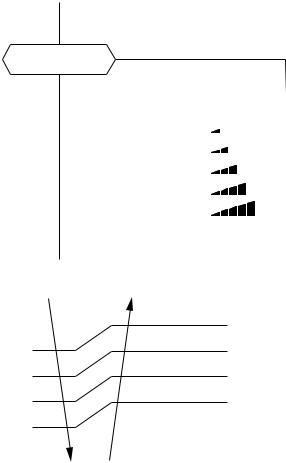
|
|
Item |
|
|
|
|
|
Operation flow and applicable data, etc. |
|
|
|
|
|
Description |
|||||||||||||||
|
|
|
|
|
|
|
|
|
|
|
|
|
|
|
|
|
|
|
|
|
|
|
|
|
|
|
|
||
2. Indoor fan |
|
|
<In cooling operation> |
|
|
|
|
|
|
|
|
|
|
|
|
|
|
||||||||||||
|
motor control |
|
(This operation controls the fan speed at indoor unit side.) |
|
|
|
* Symbols |
|
|||||||||||||||||||||
|
|
|
|
|
|
|
|
|
|
||||||||||||||||||||
|
|
|
|
|
|
The indoor fan (cross flow fan) is operated by the phase- |
|
|
|
UH |
: Ultra High |
|
|||||||||||||||||
|
|
|
|
|
|
control induction motor. The fan rotates in 5 stages in |
|
|
|
H |
: High |
|
|
||||||||||||||||
|
|
|
|
|
|
MANUAL mode, and in 5 stages in AUTO mode, respec- |
|
|
|
M+ |
: Medium+ |
|
|||||||||||||||||
|
|
|
|
|
|
tively. (Table 1) |
|
|
|
|
|
|
|
|
|
|
|
|
M |
: Medium |
|
||||||||
|
|
|
|
|
|
|
|
|
|
|
|
|
|
|
|
|
|
|
|
|
|
|
|
L+ |
: Low+ |
|
|
||
|
|
|
|
|
|
|
|
|
|
|
|
|
|
|
|
|
|
|
|
|
|
|
|
|
|
||||
|
|
|
|
|
|
|
|
|
|
|
|
|
|
|
|
|
|
|
|
|
|
|
|
L |
: Low |
|
|
||
|
|
|
COOL ON |
|
|
|
|
|
|
|
|
|
|
|
|
|
|
|
|
|
L- |
: Low– |
|
|
|||||
|
|
|
|
|
|
|
|
|
|
|
|
|
|
|
|
|
|
|
|
UL |
: Ultra Low |
|
|||||||
|
|
|
|
|
|
|
|
|
|
|
|
|
|
|
|
|
|
|
|
|
|
|
|
|
|||||
|
|
Fan speed setup |
|
|
|
|
|
|
|
|
|
|
|
|
|
|
|
|
SUL |
: Super Ultra Low |
|
||||||||
|
|
|
|
|
|
|
|
|
|
|
|
|
|
|
|
|
|
|
|
|
|
||||||||
|
|
|
|
MANUAL |
|
|
|
|
|
|
|
|
* The fan speed broadly varies due |
||||||||||||||||
|
|
|
|
|
|
|
|
|
|
|
|
|
|
|
|
|
|
(Fig. 1) |
|
|
|||||||||
|
|
|
|
|
|
|
|
|
|
|
|
|
|
|
|
|
|
|
|
to position of the louver, etc. |
|||||||||
|
|
|
|
|
|
|
|
|
|
|
|
|
|
|
|
|
|
|
|
||||||||||
|
|
|
|
|
|
|
|
|
|
|
|
|
|
|
|
|
|
|
|
|
|
|
The described value indicates one |
||||||
|
|
|
AUTO |
|
|
|
|
|
Indication |
|
|
Fan speed |
|
|
under condition of inclining |
||||||||||||||
|
|
|
|
|
|
|
|
|
|
L |
|
|
|
|
|
|
|
W6 |
|
|
downward blowing. |
|
|
||||||
|
|
|
|
|
|
|
|
|
|
|
|
|
|
|
|
|
|
|
1) When setting the fan speed to L, |
||||||||||
|
|
|
|
|
|
|
|
|
|
|
|
|
|
|
|
|
|
|
|
|
|
|
|||||||
|
|
|
|
|
|
|
|
|
|
L+ |
|
|
|
|
|
(L + M) / 2 |
|
|
|||||||||||
|
|
|
|
|
|
|
|
|
|
|
|
|
|
|
|
|
|
L+, M, M+ or H on the remote |
|||||||||||
|
|
|
|
|
|
|
|
|
|
|
|
|
|
|
|
|
|
|
|
|
|
|
|
||||||
|
|
|
|
|
|
|
|
|
|
M |
|
|
|
|
|
|
|
W9 |
|
|
|
controller, the operation is |
|||||||
|
|
|
|
|
|
|
|
|
|
|
|
|
|
|
|
|
|
|
|
|
|
|
|
performed with the constant |
|||||
|
|
|
|
|
|
|
|
|
|
M+ |
|
|
|
|
|
(M + H) / 2 |
|
|
|
||||||||||
|
|
|
|
|
|
|
|
|
|
|
|
|
|
|
|
|
|
speed shown in Fig. 1. |
|||||||||||
|
|
|
|
|
|
|
|
|
|
|
|
|
|
|
|
|
|
|
|
|
|
|
|
||||||
|
|
|
|
|
|
|
|
|
|
H |
|
|
|
|
|
|
|
WC |
|
|
2) When setting the fan speed to |
||||||||
|
|
|
|
|
|
|
|
|
|
|
|
|
|
|
|
|
|
|
|
|
|
|
|
AUTO on the remote controller, |
|||||
|
|
|
|
|
|
|
|
|
|
|
|
|
|
|
|
|
|
(Fig. 2) |
|
|
|
revolution of the fan motor is |
|||||||
|
|
|
|
|
|
|
|
|
|
|
|
|
|
|
|
|
|
|
|
|
|
|
|
controlled to the fan speed level |
|||||
|
|
|
|
|
|
|
|
|
|
|
|
|
|
|
|
|
|
|
|
|
|
|
|
shown in Fig. 2 and Table 1 |
|||||
|
|
Ta |
|
|
|
|
|
|
Air volume AUTO |
|
|
|
|
|
|
|
|
|
|
according to the setup tempera- |
|||||||||
|
|
|
|
|
|
|
|
|
|
|
|
|
|
|
|
|
|
|
|
|
|
|
ture, room temperature, and heat |
||||||
|
[˚C] |
|
|
|
|
|
|
|
|
|
|
|
|
|
|
|
|
|
|
|
|
|
|||||||
|
|
|
|
|
|
|
|
|
|
|
|
|
|
|
|
|
|
|
|
|
|
exchanger temperature. |
|||||||
|
|
|
|
|
|
|
|
|
|
M+(WB) |
|
|
|
|
|
|
|
|
|
|
|
||||||||
|
+2.5 |
|
|
|
|
|
|
|
|
|
|
|
|
|
|
|
|
|
|
|
|
|
|
|
|
||||
|
|
|
|
|
|
|
|
|
|
|
|
|
|
|
|
|
|
|
|
|
|
|
|
|
|
|
|
||
|
+2.0 |
a |
|
|
|
|
|
*3 |
|
|
|
*3 : Fan speed = (M + –L) x 3/4 + L |
|
|
|
|
|
|
|
|
|
||||||||
|
|
|
|
|
|
|
|
|
|
|
|
|
|
|
|
|
|
|
|
|
|
|
|
|
|
|
|
||
|
+1.5 |
b |
|
|
|
|
|
*4 |
|
|
|
*4 : Fan speed = (M + –L) x 2/4 + L |
|
|
|
|
|
|
|
|
|
||||||||
|
|
|
|
|
|
|
|
|
|
|
|
|
|
|
|
|
|
|
|
|
|
|
|
|
|
|
|
||
|
+1.0 |
c |
|
|
|
|
|
*5 |
|
|
|
*5 : Fan speed = (M + –L) x 1/4 + L |
|
|
|
|
|
|
|
|
|
||||||||
|
+0.5 |
d |
|
|
|
|
|
|
L(W6) |
|
|
(Linear approximation |
|
|
|
|
|
|
|
|
|
||||||||
|
|
|
|
|
|
|
|
|
|
|
|
|
|
|
|
|
|
|
|
|
|||||||||
|
|
|
|
|
|
|
|
|
|
|
|
from M+ and L) |
|
|
|
|
|
|
|
|
|
|
|
|
|||||
|
Tsc |
e |
|
|
|
|
|
|
|
|
|
|
|
|
|
|
|
|
|
|
|
|
|
|
|||||
|
|
|
|
|
|
|
|
|
|
|
|
|
|
|
|
|
|
|
|
|
|
|
|
|
|
|
|||
|
|
|
|
|
|
|
|
|
|
|
|
|
|
|
|
|
|
|
|
|
|
|
|
|
|
||||
|
|
|
|
|
|
|
|
|
|
|
|
|
|
|
|
|
|
|
|
|
|
|
|
|
|||||
|
|
|
|
|
|
|
|
|
|
|
|
|
(Table 1) Indoor fan air flow rate |
|
|
|
|
|
|
|
|
|
|||||||
|
|
|
|
|
|
|
|
|
|
|
|
|
|
|
|
|
|
|
|
|
|
|
|
|
|
|
|||
|
Fan speed |
|
|
|
|
|
|
|
|
|
RAS-B10GKVP-E |
|
RAS-B13GKVP-E |
|
RAS-B16GKVP-E |
|
|||||||||||||
|
COOL |
HEAT |
|
DRY |
|
|
|
|
|
|
|
|
|
|
|
|
|
|
|
|
|
|
|
||||||
|
|
|
Fan speed |
Air flow rate |
Fan speed |
|
Air flow rate |
|
Fan speed |
|
Air flow rate |
|
|||||||||||||||||
|
|
level |
|
|
|
|
|
|
|||||||||||||||||||||
|
|
|
|
|
|
|
|
|
|
|
|
|
|
||||||||||||||||
|
|
|
|
|
|
|
|
|
|
|
|
|
(rpm) |
|
(m3/h) |
|
(rpm) |
|
|
(m3/h) |
|
(rpm) |
|
(m3/h) |
|
||||
|
|
WF |
|
|
|
|
UH |
|
|
|
|
1630 |
|
684 |
|
1650 |
|
694 |
|
|
1650 |
|
694 |
|
|||||
|
|
WE |
|
|
|
|
H |
|
|
|
|
1480 |
|
609 |
|
1530 |
|
634 |
|
|
1580 |
|
659 |
|
|||||
|
|
WD |
|
UH |
M+ |
|
|
|
|
1400 |
|
569 |
|
1440 |
|
589 |
|
|
1550 |
|
644 |
|
|||||||
|
|
WC |
|
H |
|
|
|
|
|
1350 |
|
544 |
|
1390 |
|
564 |
|
|
1530 |
|
634 |
|
|||||||
|
|
WB |
|
M+ |
|
|
|
|
|
1200 |
|
468 |
|
1240 |
|
488 |
|
|
1380 |
|
559 |
|
|||||||
|
|
WA |
|
|
|
|
M |
|
|
|
|
1110 |
|
423 |
|
1150 |
|
443 |
|
|
1230 |
|
483 |
|
|||||
|
|
W9 |
|
M |
L+ |
|
|
|
|
980 |
|
358 |
|
1010 |
|
373 |
|
|
1080 |
|
408 |
|
|||||||
|
|
W8 |
|
|
|
|
L |
|
|
|
|
910 |
|
323 |
|
910 |
|
323 |
|
|
970 |
|
353 |
|
|||||
|
|
W7 |
|
L+ |
L– |
|
L+ |
|
|
900 |
|
318 |
|
900 |
|
318 |
|
|
960 |
|
348 |
|
|||||||
|
|
W6 |
|
L |
|
|
L |
|
|
890 |
|
313 |
|
890 |
|
313 |
|
|
950 |
|
343 |
|
|||||||
|
|
W5 |
|
L– |
UL |
|
L– |
|
|
880 |
|
308 |
|
880 |
|
308 |
|
|
940 |
|
338 |
|
|||||||
|
|
W4 |
|
UL |
|
|
UL |
|
|
730 |
|
232 |
|
730 |
|
232 |
|
|
790 |
|
263 |
|
|||||||
|
|
W3 |
|
SUL |
|
|
SUL |
|
|
580 |
|
157 |
|
580 |
|
157 |
|
|
640 |
|
187 |
|
|||||||
|
|
W2 |
|
|
|
|
SUL |
|
|
|
|
430 |
|
82 |
|
430 |
|
82 |
|
|
490 |
|
112 |
|
|||||
|
|
W1 |
|
|
|
|
|
|
|
|
|
400 |
|
67 |
|
400 |
|
67 |
|
|
400 |
|
67 |
|
|||||
|
|
|
|
|
|
|
|
|
|
|
|
|
|
|
|
|
|
|
|
|
|
|
|
|
|
|
|
|
|
|
|
|
|
|
|
|
|
|
|
|
|
|
|
|
|
|
|
|
|
|
|
|
|
|
|
|
|
|
|
– 28 –
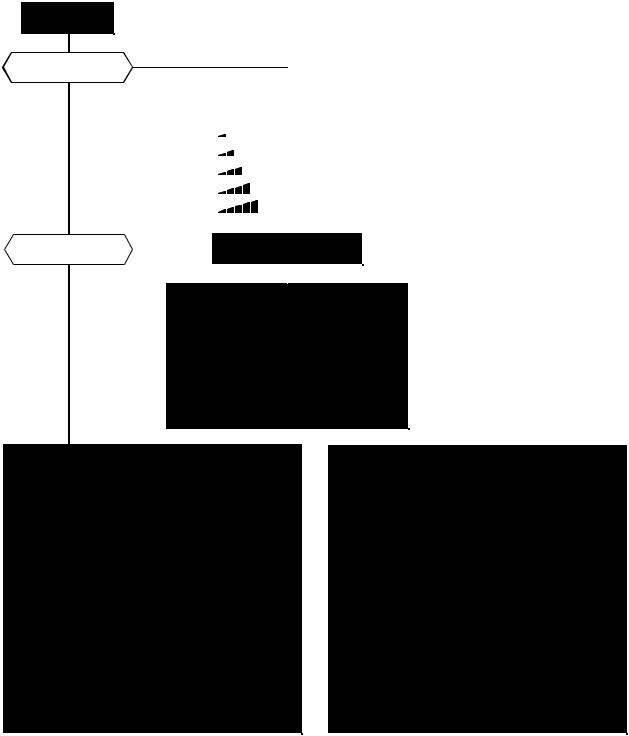
|
|
|
Item |
|
|
|
|
|
|
|
Operation flow and applicable data, etc. |
|
|
|
|
|
|
Description |
||||||||||||||
|
|
|
|
|
|
|
|
|
|
|
|
|
|
|
|
|
|
|
|
|
|
|
|
|
|
|
|
|
|
|
||
2. Indoor fan |
|
|
|
<In heating operation> |
|
|
|
|
|
|
|
|
|
1) When setting the fan speed to L, |
||||||||||||||||||
|
motor control |
|
|
|
|
|
|
|
|
|
|
|
|
|
|
|
|
L+, M, M+ or H on the remote |
||||||||||||||
|
|
|
|
|
|
|
|
|
|
|
|
|
|
|
|
|
|
|
|
|
|
|
|
|
|
|
|
|
controller, the operation is per- |
|||
|
|
|
|
|
|
|
|
|
|
|
|
|
|
|
|
|
|
|
|
|
|
|
|
|
|
|
|
|
formed with the constant speed |
|||
|
|
|
|
HEAT ON |
|
|
|
|
|
|
|
|
|
|
|
|
|
|
|
|
|
|
|
|
|
|
shown in Fig. 3 and Table 1. |
|||||
|
|
|
|
|
|
|
|
|
|
|
|
|
|
|
|
|
|
|
|
|||||||||||||
|
|
|
|
|
|
|
|
|
|
|
|
|
|
|
|
|
|
|
|
|
|
|
|
|
|
|
|
2) When setting the fan speed to |
||||
|
|
|
|
|
|
|
|
|
|
|
|
|
|
|
|
|
|
|
|
|
|
|
|
|
|
|
|
|
AUTO on the remote controller, |
|||
|
|
|
|
|
|
|
|
|
|
|
|
|
|
|
|
|
|
|
|
|
|
|
|
|
|
|
|
|
||||
|
|
|
|
|
|
|
|
|
|
|
|
|
MANUAL |
|
|
|
|
|
|
|
|
|
|
|
revolution of the fan motor is |
|||||||
|
Fan speed setup |
|
|
(Fig. 3) |
|
|
|
|
||||||||||||||||||||||||
|
|
|
|
|
|
|
|
|
|
|
|
|
|
|
|
|
|
|
|
|
|
|
|
|
controlled to the fan speed level |
|||||||
|
|
|
|
|
|
|
|
|
|
|
|
|
|
|
|
|
|
|
|
|
|
|
|
|
||||||||
|
|
|
|
|
|
|
|
|
|
|
|
|
|
|
|
|
|
|
|
|
|
|
|
|
|
|
|
|
shown in Fig. 5 according to the set |
|||
|
|
|
|
|
|
|
|
|
|
|
|
|
|
Indication |
|
|
Fan speed |
|
|
|
|
temperature and room temperature. |
||||||||||
|
|
|
|
|
|
|
|
|
|
|
|
|
|
|
|
|
|
|
|
|
|
|
|
|
|
|
|
3) Min air flow rate is controlled by |
||||
|
|
|
|
|
|
|
|
|
|
|
|
|
|
L |
|
|
|
W8 |
|
|
||||||||||||
|
|
|
|
|
|
|
|
|
|
|
|
|
|
|
|
|
|
|
|
|
temperature of the indoor heat |
|||||||||||
|
|
|
|
|
|
|
|
|
|
|
|
|
|
|
|
|
|
|
|
|
|
|
|
|
|
|
|
|
||||
|
|
|
|
|
|
|
|
|
|
|
|
|
|
L+ |
|
|
(L + M) / 2 |
|
|
|
|
|||||||||||
|
|
|
|
AUTO |
|
|
|
|
|
|
|
|
|
|
exchanger (Tc) as shown in Fig. 4. |
|||||||||||||||||
|
|
|
|
|
|
|
|
|
|
|
|
|
|
|
|
|
|
|
|
|
|
|
||||||||||
|
|
|
|
|
|
|
|
M |
|
|
|
WA |
|
|
|
4) Cold draft prevention, the fan |
||||||||||||||||
|
|
|
|
|
|
|
|
|
|
|
|
|
|
|
|
|
|
|
|
|||||||||||||
|
|
|
|
|
|
|
|
|
|
|
|
|
|
|
|
|
|
|
|
|
|
|
|
|
|
|
|
|||||
|
|
|
|
|
|
|
|
|
|
|
|
|
|
M+ |
|
|
(M + H) / 2 |
|
|
|
|
speed is controlled by temperature |
||||||||||
|
|
|
|
|
|
|
|
|
|
|
|
|
|
|
|
|
|
|
|
|
|
|
|
|
|
|
|
|
of the indoor heat exchanger (Tc) |
|||
|
|
|
|
|
|
|
|
|
|
|
|
|
|
H |
|
|
|
WE |
|
|
|
|
||||||||||
|
|
|
|
|
|
|
|
|
|
|
|
|
|
|
|
|
|
|
|
|
as shown in Fig. 6. |
|||||||||||
|
|
|
|
|
|
|
|
|
|
|
|
|
|
|
|
|
|
|
|
|
|
|
|
|
|
|
|
|
||||
|
|
|
|
TC ≥ 42˚C |
|
|
|
|
YES |
|
|
|
|
|
|
|
|
|
|
|
|
|
|
|
||||||||
|
|
|
|
|
|
|
|
|
|
|
|
|
|
|
|
|
|
|
|
|
|
|
|
|
|
|
||||||
|
|
|
|
|
|
|
|
|
|
|
|
|
|
Min air flow rate control |
|
|
|
|
|
|
|
|
|
|||||||||
|
|
|
|
|
|
|
|
|
|
|
|
|
|
|
|
|
|
|
||||||||||||||
|
|
|
|
NO |
|
|
|
|
|
|
|
|
|
|
|
|
|
|
|
|
|
|
|
|
|
|
|
|
|
|
|
|
|
|
|
|
|
|
|
|
|
|
|
|
|
|
|
|
|
|
|
|
|
|
|
|
|
|
|
|
|
|
|
|
|
|
|
|
|
|
|
|
|
|
|
|
|
|
|
|
|
|
|
|
|
|
|
|
|
|
|
|
|
|
|
|
|
|
|
|
|
|
|
|
|
|
|
|
|
|
|
|
Tc |
Limited to Min WD tap |
|
|
|
|
|
|
|
|
|||||||||
|
|
|
|
|
|
|
|
|
|
|
|
|
|
|
|
|
|
|
|
|
|
|
|
|
|
|
|
|||||
|
|
|
|
|
|
|
|
|
|
|
|
|
|
52 |
|
|
|
|
|
|
|
|
|
|
|
|
|
|
|
|
||
|
|
|
|
|
|
|
|
|
|
|
|
|
|
51 |
|
|
|
|
|
|
|
|
|
|
|
|
|
|
|
|
||
|
|
|
|
|
|
|
|
|
|
|
|
|
|
42 |
|
|
|
|
|
|
|
|
|
|
|
|
|
|
|
|
||
|
|
|
|
|
|
|
|
|
|
|
|
|
|
41 |
|
|
No limit |
|
|
|
|
|
|
|
|
|
|
|
|
|||
|
|
|
|
|
|
|
|
|
|
|
|
|
|
|
|
|
|
|
|
|
|
|
|
|
|
|
|
|
|
|
||
|
|
|
|
|
|
|
|
|
|
|
|
|
|
* Fan speed = |
|
|
|
|
|
|
|
|
|
|
|
|
|
|
||||
|
|
|
|
|
|
|
|
|
|
(Fig. 4) |
(TC |
|
|
W8) + W8 |
|
|
|
|
|
|
||||||||||||
|
|
|
|
|
|
|
|
|
|
|
|
|
|
|
|
|
|
|
|
|
|
|
|
|
|
|
|
|
|
Cold draft preventive control |
||
|
Basic fan control |
|
|
Fan speed |
|
|
|
|
|
|
Tc |
|
|
|
|
|
|
|||||||||||||||
|
TA [ C] |
|
|
|
|
|
|
|
|
|
|
|
|
|
|
|
|
|
|
|
|
|
|
|
|
|||||||
|
|
|
|
|
|
|
|
|
|
|
|
|
|
AUTO |
|
|
|
|
|
|
|
|
|
|
|
|
||||||
|
b |
|
|
|
|
|
|
|
|
|
|
|
|
|
|
|
|
46 |
46 |
|
34 |
|
|
H (WE) |
||||||||
|
TSC |
|
|
|
|
|
|
|
|
|
|
|
|
|
|
|
|
|
|
|
|
|
||||||||||
|
|
|
|
|
|
|
|
|
|
|
|
|
|
L (W8) |
|
|
|
|
45 |
45 |
|
33 |
|
|
||||||||
|
–0.5 |
c |
|
|
|
|
|
|
|
|
|
|
|
|
|
|
|
|
|
|
|
Line-approximate |
||||||||||
|
|
|
|
|
|
|
|
|
|
|
|
|
|
|
|
|
|
|
|
|
|
|
|
|
|
|
||||||
|
|
|
|
|
|
|
|
|
|
|
|
|
|
|
|
|
|
|
|
|
|
|
|
|
|
|
|
|||||
|
|
|
|
d |
|
|
|
|
|
|
|
|
|
*1 |
|
|
|
|
|
33 |
33 |
|
21 |
|
|
H and SUL with Tc. |
||||||
|
–1.0 |
|
|
|
|
|
|
|
|
|
|
|
|
|
|
|
|
|
|
|
||||||||||||
|
|
|
|
|
|
|
|
|
|
|
|
|
|
|
|
|
|
|
32 |
32 |
|
20 |
|
|
|
|
||||||
|
e |
|
|
|
|
|
|
|
|
|
*2 |
|
|
|
|
|
|
|
|
|
|
|||||||||||
|
|
|
|
|
|
|
|
|
|
|
|
|
|
|
|
|
|
|
||||||||||||||
|
–1.5 |
|
|
|
|
|
|
|
|
|
|
|
|
|
|
|
|
|
|
|
|
|
|
|
|
|||||||
|
|
|
|
|
|
|
|
|
|
|
|
|
|
|
|
|
|
*A+4 |
*A+4 |
*A+4 |
|
|
|
|
||||||||
|
|
|
|
|
|
|
|
|
|
|
|
|
|
|
|
|
|
|
|
|
|
|
||||||||||
|
–2.0 |
f |
|
|
|
|
|
|
|
|
|
*3 |
|
|
|
|
*A-4 |
*A-4 |
*A-4 |
|
|
SUL (W2) |
||||||||||
|
g |
|
|
|
|
|
|
|
|
|
|
|
|
|
|
|
Stop |
|||||||||||||||
|
–2.5 |
|
|
|
|
|
|
|
|
|
|
|
|
|
|
|
|
|
|
|
|
|
|
|
|
|
|
|||||
|
|
|
|
|
|
|
|
|
|
|
|
|
|
|
|
|
|
|
|
|
|
|
|
|
|
|||||||
|
|
|
|
|
|
|
|
|
|
|
|
|
|
|
|
|
|
|
|
|
|
|
|
|
|
|
|
|
||||
|
|
|
|
|
|
|
|
|
|
|
|
|
|
|
|
|
|
|
|
|
|
|
|
|
|
|
|
|
|
|||
|
–5.0 |
|
|
|
|
|
|
|
|
|
|
|
|
|
M+ (WD) |
|
|
|
|
|
|
|
|
|
|
|
Fan speed MANUAL in starting |
|||||
|
|
|
|
|
|
|
|
|
|
|
|
|
|
|
|
|
|
|
|
|
|
|
|
|
|
|
|
|
|
Fan speed AUTO in stability |
||
5.5 |
|
|
|
|
|
|
|
|
|
|
|
|
|
H (WE) |
|
|
|
|
|
|
|
|
|
|
|
Fan speed AUTO in starting |
||||||
|
|
|
|
|
|
|
|
|
|
|
|
|
|
|
|
|
|
|
|
|
|
|
|
|
|
|
|
|
|
|
||
*1: |
|
|
|
|
|
|
|
|
|
|
4 + L |
|
|
* No limitation while fan speed MANUAL mode is in stability. |
||||||||||||||||||
|
|
|
|
|
|
|
|
|
|
|
|
|||||||||||||||||||||
*2: |
|
|
|
|
|
|
|
|
|
|
4 + L |
|
|
|||||||||||||||||||
|
|
|
|
|
|
|
|
|
|
|
|
* A: When Tsc ≥ 24, A is 24, and when Tsc < 24, A is Tsc |
||||||||||||||||||||
|
|
|
|
|
|
|
|
|
|
|
|
|||||||||||||||||||||
|
|
|
|
|
|
|
|
|
|
|
|
|
|
|
|
|
|
|
|
|
||||||||||||
|
|
|
|
|
|
|
|
|
|
|
|
|
|
|
|
|
|
|
|
|
|
Tsc: Set value |
|
|
|
|
|
|
||||
|
|
|
|
|
|
|
|
|
|
|
(Fig. 5) |
|
|
|
|
|
|
|
|
|
|
|
|
|
|
|
|
(Fig. 6) |
||||
|
[In starting and in stability] |
|
|
|
|
|
|
|
|
|
|
|
|
|
|
|
|
|
|
|
||||||||||||
|
|
|
|
|
|
|
|
|
|
|
|
|
|
|
|
|
|
|
|
|
|
|
|
|
|
|
|
|
|
|
|
|
|
|
|
|
|
|
|
|
|
|
|
|
|
|
In starting |
|
|
|
|
|
|
|
|
|
|
|
In stability |
|
|||||
|
|
|
|
|
|
|
|
|
|
|
|
|
||||||||||||||||||||
|
|
|
|
|
• Until 12 minutes passed after operation start |
|
• |
|
When 12 to 25 minutes passed after operation start |
|
||||||||||||||||||||||
|
FAN AUTO |
• When 12 to 25 minutes passed after operation |
|
|
|
and room temp. is higher than (set temp. –3°C) |
|
|||||||||||||||||||||||||
|
|
|
|
|
start and room temp. is 3°C or lower than set temp. |
• |
|
When 25 minutes or more passed after operation start |
|
|||||||||||||||||||||||
|
|
|
|
|
|
|
|
|
|
|
||||||||||||||||||||||
|
FAN Manual |
• Room temp. < Set temp. –4°C |
|
|
|
• Room temp. ≥ |
Set temp. –3.5°C |
|
||||||||||||||||||||||||
|
|
|
|
|
|
|
|
|
|
|
|
|
|
|
|
|
|
|
|
|
|
|
|
|
|
|
|
|
|
|
|
|
|
|
|
|
|
|
|
|
|
|
|
|
|
|
|
|
|
|
|
|
|
|
|
|
|
|
|
|
|
|
|
|
|
– 29 –
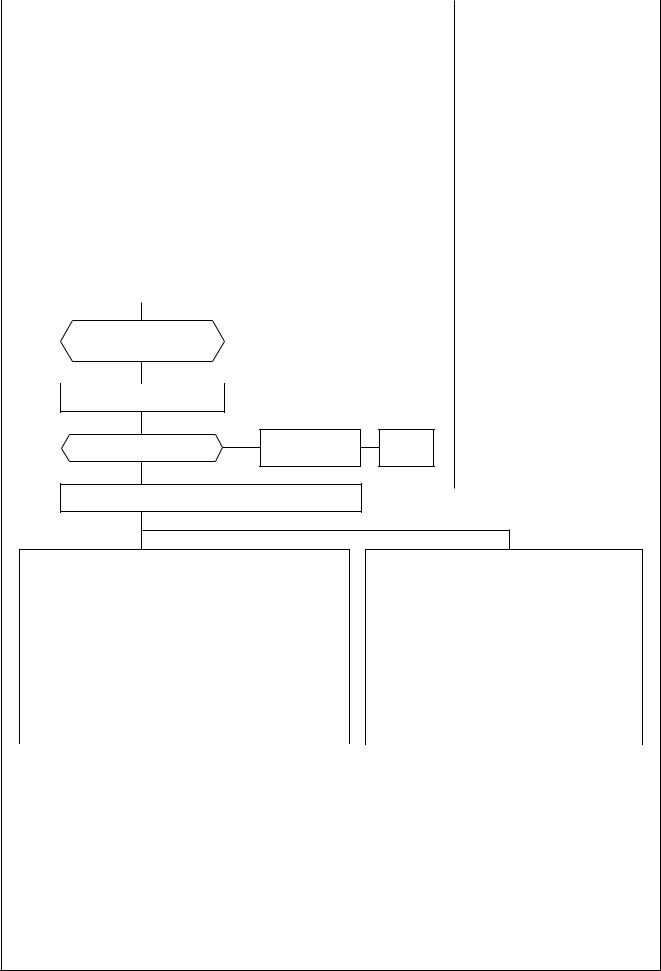
Item |
|
Operation flow and applicable data, etc. |
Description |
||||
|
|
|
|
|
|
|
|
3. Outdoor fan |
The blowing air volume at the outdoor unit side is controlled. |
1) The operation command sent |
|||||
motor control |
Receiving the operation command from the controller of |
from the remote controller is |
|||||
|
|
indoor unit, the controller of outdoor unit controls fan speed. |
processed by the indoor unit |
||||
|
|
* For the fan motor, a DC motor with non-stage variable |
controller and transferred to the |
||||
|
|
controller of the outdoor unit. |
|||||
|
|
speed system is used. However, it is limited to 8 stages for |
|||||
|
|
2) When strong wind blows at |
|||||
|
|
reasons of controlling. |
|
|
|||
|
|
|
|
|
|
|
outdoor side, the operation of air |
|
|
|
|
|
|
|
conditioner continues with the |
|
|
|
|
|
|
|
fan motor stopped. |
|
Air conditioner ON |
|
|
|
|||
|
|
|
|
3) Whether the fan is locked or not |
|||
|
(Remote controller) |
|
|
|
|||
|
|
|
|
is detected, and the operation of |
|||
|
|
|
|
|
|
|
|
|
|
|
|
|
|
|
air conditioner stops and an |
|
Indoor unit controller |
|
|
|
alarm is displayed if the fan is |
||
|
|
|
|
locked. |
|||
|
|
|
|
|
|
|
|
|
|
|
|
|
|
|
4) According to each operation |
|
1) Outdoor unit |
|
|
|
mode, by the conditions of |
||
|
|
|
|
outdoor temperature (To) and |
|||
|
operation command |
|
|
|
|||
|
(Outdoor fan control) |
|
|
|
compressor revolution, the speed |
||
|
|
|
|
|
|
|
of the outdoor fan shown in the |
|
|
|
|
|
|
|
|
|
|
|
|
|
|
|
table is selected. |
|
2) Fan speed ≥ 400 |
YES |
OFF status of |
|
|
||
|
when the motor stopped. |
|
fan motor continues. |
|
|
||
|
|
|
NO |
|
|
|
|
|
|
|
|
|
|
|
|
|
|
|
|
|
|
|
|
Fan motor ON |
|
|
YES |
Air conditioner |
Alarm |
3) Fan lock |
OFF |
display |
|
||
NO |
|
|
4) Motor operates as shown in the table below.
In cooling operation
Compressor speed (rps) |
~ 13.8 |
~ 31.7 |
32.3 ~ MAX |
|||||
MIN |
MAX |
MIN |
MAX |
MIN |
MAX |
|||
|
|
|||||||
|
|
|
|
|
|
|
|
|
|
To > 38°C |
f 2 |
f 3 |
f C |
f D |
f E |
f F |
|
|
To > 28°C |
f 2 |
f 3 |
f B |
f C |
f E |
f F |
|
To |
To > 15°C |
f 2 |
f 3 |
f 8 |
f 9 |
f A |
f B |
|
|
To > 5.5°C |
f 2 |
f 3 |
f 6 |
f 7 |
f 8 |
f 9 |
|
|
To > 0°C |
f 1 |
f 2 |
f 4 |
f 5 |
f 6 |
f 7 |
|
During |
To > 38°C |
f 2 |
f 3 |
f B |
f C |
f C |
f D |
|
ECO mode |
To < 38°C |
f 2 |
f 3 |
f 2 |
f 3 |
f B |
f C |
|
|
|
|
|
|
|
|
|
|
When To is abnormal |
f D |
f F |
f D |
f F |
f D |
f F |
||
In Heating operation
Compressor speed (rps) |
~16.8 |
~47.9 |
48.5 ~ MAX |
||
|
To > 15°C |
f 3 |
f 8 |
f 9 |
|
To |
To < 15°C |
f 3 |
f 9 |
f A |
|
To < 5.5°C |
f 8 |
f A |
f D |
||
|
|||||
|
|
|
|
|
|
|
To < –5.0°C |
f B |
f C |
f D |
|
|
|
|
|
|
|
|
To > 15°C |
f 3 |
f 3 |
f 6 |
|
During |
To < 15°C |
f 3 |
f 3 |
f 8 |
|
ECO mode |
To < 5.5°C |
f 5 |
f 9 |
f 9 |
|
|
To < –5.5°C |
f 7 |
f A |
f B |
|
|
|
|
|
|
|
When To is abnormal |
f A |
f B |
f D |
||
|
|
|
|
|
|
Outdoor fan speed (rpm)
Tap |
10GAVP-E |
13GAVP-E |
16GAVP-E |
|
|
|
|
|
|
f 1 |
200 |
200 |
200 |
|
|
|
|
|
|
f 2 |
300 |
300 |
300 |
|
|
|
|
|
|
f 3 |
390 |
390 |
390 |
|
|
|
|
|
|
f 4 |
450 |
450 |
450 |
|
|
|
|
|
|
f 5 |
500 |
500 |
500 |
|
|
|
|
|
|
f 6 |
500 |
500 |
500 |
|
|
|
|
|
|
f 7 |
600 |
600 |
600 |
|
|
|
|
|
|
f 8 |
600 |
600 |
600 |
|
|
|
|
|
|
|
|
|
|
|
Tap |
10GAVP-E |
13GAVP-E |
16GAVP-E |
|
|
|
|
|
|
f 9 |
700 |
|
700 |
700 |
|
|
|
|
|
f A |
700 |
|
700 |
700 |
|
|
|
|
|
f B |
700 |
|
700 |
700 |
|
|
|
|
|
f C |
700 |
|
700 |
700 |
|
|
|
|
|
f D |
750 |
|
840 |
920 |
|
|
|
|
|
f E |
750 |
|
840 |
920 |
|
|
|
|
|
f F |
750 |
|
840 |
920 |
|
|
|
|
|
|
|
|
|
|
|
|
|
|
|
– 30 –
